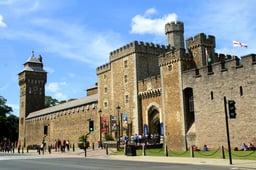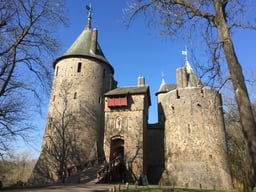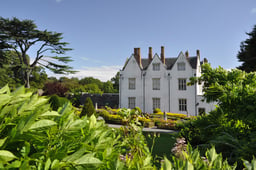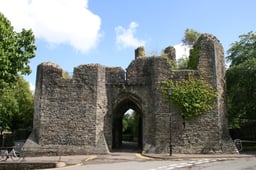Cardiff

Cardiff

Cardiff | ||||||||||||||||||||||||||||||||||||||||||||||||||||||||||||
|---|---|---|---|---|---|---|---|---|---|---|---|---|---|---|---|---|---|---|---|---|---|---|---|---|---|---|---|---|---|---|---|---|---|---|---|---|---|---|---|---|---|---|---|---|---|---|---|---|---|---|---|---|---|---|---|---|---|---|---|---|
Capital city | ||||||||||||||||||||||||||||||||||||||||||||||||||||||||||||
| City and County of Cardiff | ||||||||||||||||||||||||||||||||||||||||||||||||||||||||||||
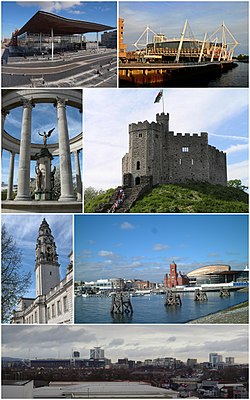 Clockwise from top left: The Senedd, Principality Stadium, Norman keep, Cardiff Bay, Cardiff City Centre, City Hall clock tower, Welsh National War Memorial | ||||||||||||||||||||||||||||||||||||||||||||||||||||||||||||
| Motto(s): "Y ddraig goch ddyry cychwyn" ("The red dragon will lead the way") | ||||||||||||||||||||||||||||||||||||||||||||||||||||||||||||
 City and County of Cardiff and (inset) within Wales | ||||||||||||||||||||||||||||||||||||||||||||||||||||||||||||
| Coordinates:51°29′N 3°11′W [239] | ||||||||||||||||||||||||||||||||||||||||||||||||||||||||||||
| Sovereign state | United Kingdom | |||||||||||||||||||||||||||||||||||||||||||||||||||||||||||
| Country | Wales | |||||||||||||||||||||||||||||||||||||||||||||||||||||||||||
| Ceremonial county | South Glamorgan | |||||||||||||||||||||||||||||||||||||||||||||||||||||||||||
| Historic County | Glamorgan | |||||||||||||||||||||||||||||||||||||||||||||||||||||||||||
| City status | 1905 | |||||||||||||||||||||||||||||||||||||||||||||||||||||||||||
| Capital city | 1955 | |||||||||||||||||||||||||||||||||||||||||||||||||||||||||||
| Government | ||||||||||||||||||||||||||||||||||||||||||||||||||||||||||||
| • Cardiff Council Leader | Huw Thomas | |||||||||||||||||||||||||||||||||||||||||||||||||||||||||||
| • Welsh Assembly | List
| |||||||||||||||||||||||||||||||||||||||||||||||||||||||||||
| • UK Parliament | List
| |||||||||||||||||||||||||||||||||||||||||||||||||||||||||||
| • European Parliament | Wales | |||||||||||||||||||||||||||||||||||||||||||||||||||||||||||
| Area | ||||||||||||||||||||||||||||||||||||||||||||||||||||||||||||
| • Capital city | 54.2 sq mi (140.3 km2) | |||||||||||||||||||||||||||||||||||||||||||||||||||||||||||
| • Urban | 29.24 sq mi (75.72 km2) | |||||||||||||||||||||||||||||||||||||||||||||||||||||||||||
| Population (2017) | ||||||||||||||||||||||||||||||||||||||||||||||||||||||||||||
| • Capital city | 362,800 (Ranked 1st) from [240] ONS | |||||||||||||||||||||||||||||||||||||||||||||||||||||||||||
| • Urban | 479,000[1] | |||||||||||||||||||||||||||||||||||||||||||||||||||||||||||
| • Metro | 1,097,000 (Cardiff-South Wales Valleys) | |||||||||||||||||||||||||||||||||||||||||||||||||||||||||||
| Demonym(s) | Cardiffian | |||||||||||||||||||||||||||||||||||||||||||||||||||||||||||
| Time zone | UTC0 (GMT) | |||||||||||||||||||||||||||||||||||||||||||||||||||||||||||
| • Summer (DST) | UTC+1 (BST) | |||||||||||||||||||||||||||||||||||||||||||||||||||||||||||
| Post codes | CF | |||||||||||||||||||||||||||||||||||||||||||||||||||||||||||
| Area code(s) | 029 | |||||||||||||||||||||||||||||||||||||||||||||||||||||||||||
| Vehicle area codes | CA, CB, CC, CD, CE, CF, CG, CH, CJ, CK, CL, CM, CN, CO | |||||||||||||||||||||||||||||||||||||||||||||||||||||||||||
| Police Force | South Wales | |||||||||||||||||||||||||||||||||||||||||||||||||||||||||||
| Fire Service | South Wales | |||||||||||||||||||||||||||||||||||||||||||||||||||||||||||
| Ambulance Service | Welsh | |||||||||||||||||||||||||||||||||||||||||||||||||||||||||||
| Primary Airport | Cardiff Airport | |||||||||||||||||||||||||||||||||||||||||||||||||||||||||||
| Ethnicity (2011 Census) [2] |
| |||||||||||||||||||||||||||||||||||||||||||||||||||||||||||
| GDP | US$36.0 billion [3] | |||||||||||||||||||||||||||||||||||||||||||||||||||||||||||
| GDP per capita | US$29,674[3] | |||||||||||||||||||||||||||||||||||||||||||||||||||||||||||
| Website | Official Website [241] | |||||||||||||||||||||||||||||||||||||||||||||||||||||||||||
| Cardiff | ||||||||||||||||||||||||||||||||||||||||||||||||||||||||||||
| Climate chart (explanation) | ||||||||||||||||||||||||||||||||||||||||||||||||||||||||||||
| ||||||||||||||||||||||||||||||||||||||||||||||||||||||||||||
| ||||||||||||||||||||||||||||||||||||||||||||||||||||||||||||
J | F | M | A | M | J | J | A | S | O | N | D | |||||||||||||||||||||||||||||||||||||||||||||||||
122 8 2 | 85 9 2 | 90 11 4 | 69 14 5 | 72 17 8 | 67 20 11 | 78 22 13 | 93 22 13 | 94 19 11 | 134 15 8 | 123 11 5 | 125 9 3 | |||||||||||||||||||||||||||||||||||||||||||||||||
| Average max. and min. temperatures in °C | ||||||||||||||||||||||||||||||||||||||||||||||||||||||||||||
| Precipitation totals in mm | ||||||||||||||||||||||||||||||||||||||||||||||||||||||||||||
| Source: Met Office [242] , 1981–2010 averages | ||||||||||||||||||||||||||||||||||||||||||||||||||||||||||||
| Imperial conversion | ||||||||||||||||||||||||||||||||||||||||||||||||||||||||||||
| J | F | M | A | M | J | J | A | S | O | N | D | |||||||||||||||||||||||||||||||||||||||||||||||||
4.8 47 36 | 3.4 47 36 | 3.5 52 39 | 2.7 57 41 | 2.8 63 47 | 2.6 68 52 | 3.1 71 56 | 3.7 71 55 | 3.7 66 51 | 5.3 59 46 | 4.9 52 40 | 4.9 48 37 | |||||||||||||||||||||||||||||||||||||||||||||||||
| Average max. and min. temperatures in °F | ||||||||||||||||||||||||||||||||||||||||||||||||||||||||||||
| Precipitation totals in inches | ||||||||||||||||||||||||||||||||||||||||||||||||||||||||||||
Cardiff (Welsh: Caerdydd [kairˈdiːð, kaːɨrˈdɨːð] (listen)) is the capital of Wales and its largest city. The eleventh-largest city in the United Kingdom, it is Wales' chief commercial centre, the base for most national cultural institutions and Welsh media, and the seat of the National Assembly for Wales. At the 2011 census, the unitary authority area population was estimated to be 346,090,[4] and the wider urban area 479,000.[5] Cardiff is a significant tourist centre and the most popular visitor destination in Wales with 21.3 million visitors in 2017.[6] In 2011, Cardiff was ranked sixth in the world in National Geographic's alternative tourist destinations.[7]
Cardiff is the county town of the historic county of Glamorgan, and in 1974, South Glamorgan. Cardiff is part of the Eurocities network of the largest European cities.[8] A small town until the early 19th century, its prominence as a major port for the transport of coal following the arrival of industry in the region contributed to its rise as a major city. In 1905, Cardiff was made a city and proclaimed the capital of Wales in 1955. At the 2011 Census the population was 346,090. The Cardiff Built-up Area covers a slightly larger area outside the county boundary and includes the towns of Dinas Powys and Penarth.
Since the 1980s, Cardiff has seen significant development. A new waterfront area at Cardiff Bay contains the Senedd building, home to the Welsh Assembly and the Wales Millennium Centre arts complex. Current developments include the continuation of the redevelopment of the Cardiff Bay and city centre areas with projects such as the Cardiff International Sports Village, the BBC drama village,[9] and a new business district in the city centre.[10] Sporting venues in the city include the Principality Stadium—the national stadium and the home of the Wales national rugby union team—Sophia Gardens (the home of Glamorgan County Cricket Club), Cardiff City Stadium (the home of Cardiff City football team and the Wales football team), Cardiff International Sports Stadium (the home of Cardiff Amateur Athletic Club), Cardiff Arms Park (the home of Cardiff Blues and Cardiff RFC rugby union teams) and Ice Arena Wales (the home of Cardiff Devils ice hockey team). The city hosted the 1958 British Empire and Commonwealth Games. Cardiff was awarded European City of Sport due to its role in hosting major international sporting events in 2009 and again in 2014.[11] The Principality Stadium hosted 11 football matches as part of the 2012 Summer Olympics, including the games' opening event and the men's bronze medal match.[12]
Cardiff | ||||||||||||||||||||||||||||||||||||||||||||||||||||||||||||
|---|---|---|---|---|---|---|---|---|---|---|---|---|---|---|---|---|---|---|---|---|---|---|---|---|---|---|---|---|---|---|---|---|---|---|---|---|---|---|---|---|---|---|---|---|---|---|---|---|---|---|---|---|---|---|---|---|---|---|---|---|
Capital city | ||||||||||||||||||||||||||||||||||||||||||||||||||||||||||||
| City and County of Cardiff | ||||||||||||||||||||||||||||||||||||||||||||||||||||||||||||
 Clockwise from top left: The Senedd, Principality Stadium, Norman keep, Cardiff Bay, Cardiff City Centre, City Hall clock tower, Welsh National War Memorial | ||||||||||||||||||||||||||||||||||||||||||||||||||||||||||||
| Motto(s): "Y ddraig goch ddyry cychwyn" ("The red dragon will lead the way") | ||||||||||||||||||||||||||||||||||||||||||||||||||||||||||||
 City and County of Cardiff and (inset) within Wales | ||||||||||||||||||||||||||||||||||||||||||||||||||||||||||||
| Coordinates:51°29′N 3°11′W [239] | ||||||||||||||||||||||||||||||||||||||||||||||||||||||||||||
| Sovereign state | United Kingdom | |||||||||||||||||||||||||||||||||||||||||||||||||||||||||||
| Country | Wales | |||||||||||||||||||||||||||||||||||||||||||||||||||||||||||
| Ceremonial county | South Glamorgan | |||||||||||||||||||||||||||||||||||||||||||||||||||||||||||
| Historic County | Glamorgan | |||||||||||||||||||||||||||||||||||||||||||||||||||||||||||
| City status | 1905 | |||||||||||||||||||||||||||||||||||||||||||||||||||||||||||
| Capital city | 1955 | |||||||||||||||||||||||||||||||||||||||||||||||||||||||||||
| Government | ||||||||||||||||||||||||||||||||||||||||||||||||||||||||||||
| • Cardiff Council Leader | Huw Thomas | |||||||||||||||||||||||||||||||||||||||||||||||||||||||||||
| • Welsh Assembly | List
| |||||||||||||||||||||||||||||||||||||||||||||||||||||||||||
| • UK Parliament | List
| |||||||||||||||||||||||||||||||||||||||||||||||||||||||||||
| • European Parliament | Wales | |||||||||||||||||||||||||||||||||||||||||||||||||||||||||||
| Area | ||||||||||||||||||||||||||||||||||||||||||||||||||||||||||||
| • Capital city | 54.2 sq mi (140.3 km2) | |||||||||||||||||||||||||||||||||||||||||||||||||||||||||||
| • Urban | 29.24 sq mi (75.72 km2) | |||||||||||||||||||||||||||||||||||||||||||||||||||||||||||
| Population (2017) | ||||||||||||||||||||||||||||||||||||||||||||||||||||||||||||
| • Capital city | 362,800 (Ranked 1st) from [240] ONS | |||||||||||||||||||||||||||||||||||||||||||||||||||||||||||
| • Urban | 479,000[1] | |||||||||||||||||||||||||||||||||||||||||||||||||||||||||||
| • Metro | 1,097,000 (Cardiff-South Wales Valleys) | |||||||||||||||||||||||||||||||||||||||||||||||||||||||||||
| Demonym(s) | Cardiffian | |||||||||||||||||||||||||||||||||||||||||||||||||||||||||||
| Time zone | UTC0 (GMT) | |||||||||||||||||||||||||||||||||||||||||||||||||||||||||||
| • Summer (DST) | UTC+1 (BST) | |||||||||||||||||||||||||||||||||||||||||||||||||||||||||||
| Post codes | CF | |||||||||||||||||||||||||||||||||||||||||||||||||||||||||||
| Area code(s) | 029 | |||||||||||||||||||||||||||||||||||||||||||||||||||||||||||
| Vehicle area codes | CA, CB, CC, CD, CE, CF, CG, CH, CJ, CK, CL, CM, CN, CO | |||||||||||||||||||||||||||||||||||||||||||||||||||||||||||
| Police Force | South Wales | |||||||||||||||||||||||||||||||||||||||||||||||||||||||||||
| Fire Service | South Wales | |||||||||||||||||||||||||||||||||||||||||||||||||||||||||||
| Ambulance Service | Welsh | |||||||||||||||||||||||||||||||||||||||||||||||||||||||||||
| Primary Airport | Cardiff Airport | |||||||||||||||||||||||||||||||||||||||||||||||||||||||||||
| Ethnicity (2011 Census) [2] |
| |||||||||||||||||||||||||||||||||||||||||||||||||||||||||||
| GDP | US$36.0 billion [3] | |||||||||||||||||||||||||||||||||||||||||||||||||||||||||||
| GDP per capita | US$29,674[3] | |||||||||||||||||||||||||||||||||||||||||||||||||||||||||||
| Website | Official Website [241] | |||||||||||||||||||||||||||||||||||||||||||||||||||||||||||
| Cardiff | ||||||||||||||||||||||||||||||||||||||||||||||||||||||||||||
| Climate chart (explanation) | ||||||||||||||||||||||||||||||||||||||||||||||||||||||||||||
| ||||||||||||||||||||||||||||||||||||||||||||||||||||||||||||
| ||||||||||||||||||||||||||||||||||||||||||||||||||||||||||||
J | F | M | A | M | J | J | A | S | O | N | D | |||||||||||||||||||||||||||||||||||||||||||||||||
122 8 2 | 85 9 2 | 90 11 4 | 69 14 5 | 72 17 8 | 67 20 11 | 78 22 13 | 93 22 13 | 94 19 11 | 134 15 8 | 123 11 5 | 125 9 3 | |||||||||||||||||||||||||||||||||||||||||||||||||
| Average max. and min. temperatures in °C | ||||||||||||||||||||||||||||||||||||||||||||||||||||||||||||
| Precipitation totals in mm | ||||||||||||||||||||||||||||||||||||||||||||||||||||||||||||
| Source: Met Office [242] , 1981–2010 averages | ||||||||||||||||||||||||||||||||||||||||||||||||||||||||||||
| Imperial conversion | ||||||||||||||||||||||||||||||||||||||||||||||||||||||||||||
| J | F | M | A | M | J | J | A | S | O | N | D | |||||||||||||||||||||||||||||||||||||||||||||||||
4.8 47 36 | 3.4 47 36 | 3.5 52 39 | 2.7 57 41 | 2.8 63 47 | 2.6 68 52 | 3.1 71 56 | 3.7 71 55 | 3.7 66 51 | 5.3 59 46 | 4.9 52 40 | 4.9 48 37 | |||||||||||||||||||||||||||||||||||||||||||||||||
| Average max. and min. temperatures in °F | ||||||||||||||||||||||||||||||||||||||||||||||||||||||||||||
| Precipitation totals in inches | ||||||||||||||||||||||||||||||||||||||||||||||||||||||||||||
Etymology
Caerdydd (the Welsh name of the city) derives from the earlier Welsh form Caerdyf. The change from -dyf to -dydd shows the colloquial alteration of Welsh f [v] and dd [ð], and was perhaps also driven by folk etymology (dydd is Welsh for 'day' whereas *dyf has no obvious meaning). This sound change had probably first occurred in the Middle Ages; both forms were current in the Tudor period. Caerdyf has its origins in post-Roman Brythonic words meaning "the fort of the Taff". The fort probably refers to that established by the Romans. Caer is Welsh for fort and -dyf is in effect a form of Taf (Taff), the river which flows by Cardiff Castle, with the ⟨t⟩ showing consonant mutation to ⟨d⟩ and the vowel showing affection as a result of a (lost) genitive case ending.[13]
The anglicised form Cardiff is derived from Caerdyf, with the Welsh f [v] borrowed as ff /f/, as also happens in Taff (from Welsh Taf) and Llandaff (from Welsh Llandaf). As English does not have the vowel [ɨ] the final vowel has been borrowed as /ɪ/.
The antiquarian William Camden (1551–1623) suggested that the name Cardiff may derive from *Caer-Didi ("the Fort of Didius"), a name supposedly given in honour of Aulus Didius Gallus, governor of a nearby province at the time when the Roman fort was established. Although some sources repeat this theory, it has been rejected on linguistic grounds by modern scholars such as Professor Gwynedd Pierce.[14]
History
Origins
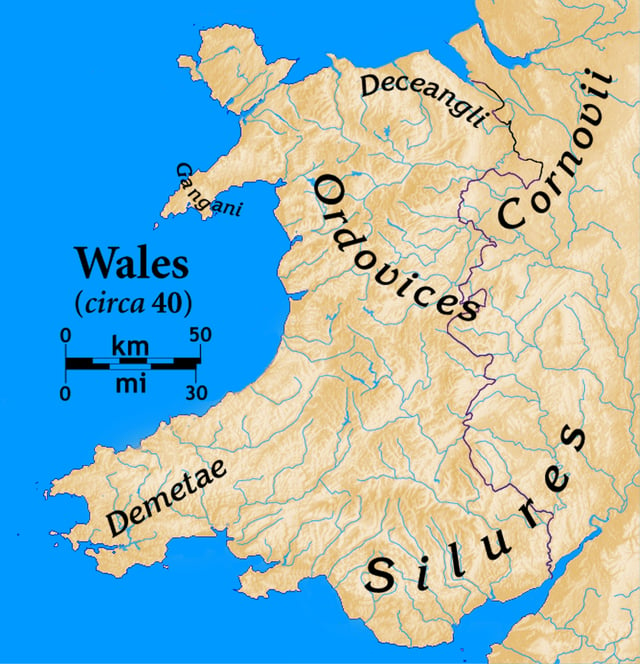
Tribes of Wales at the time of the Roman invasion and showing the modern Wales-England border
Archaeological evidence from sites in and around Cardiff: the St Lythans burial chamber near Wenvoe, (approximately 4 miles (6.4 km) to the west of Cardiff city centre); the Tinkinswood burial chamber, near St Nicholas (about 6 miles (9.7 km) west of Cardiff city centre), the Cae'rarfau Chambered Tomb, Creigiau (about 6 miles (9.7 km) northwest of Cardiff city centre) and the Gwern y Cleppa Long Barrow, near Coedkernew, Newport (about 8 miles (13 km) northeast of Cardiff city centre), all show that people had settled in the area by at least around 6000 BC, during the early Neolithic; about 1,500 years before either Stonehenge or the Great Pyramid of Giza was completed.[15][16][17][18][19] A group of five Bronze Age tumuli is at the summit of the Garth (Welsh: Mynydd y Garth), within the county's northern boundary.[20] Four Iron Age hill fort and enclosure sites have been identified within Cardiff's present-day county boundaries, including Caerau Hillfort, an enclosed area of 5.1 hectares (13 acres).[21][22][23][24]
Until the Roman conquest of Britain, Cardiff was part of the territory of the Silures – a Celtic British tribe that flourished in the Iron Age – whose territory included the areas that would become known as Breconshire, Monmouthshire and Glamorgan.[25] The 3.2-hectare (8-acre) fort established by the Romans near the mouth of the River Taff in AD 75, in what would become the north western boundary of the centre of Cardiff, was built over an extensive settlement that had been established by the Romans in the 50s AD.[26] The fort was one of a series of military outposts associated with Isca Augusta (Caerleon) that acted as border defences. The fort may have been abandoned in the early 2nd century as the area had been subdued. However, by this time a civilian settlement, or vicus, was established. It was likely made up of traders who made a living from the fort, ex-soldiers and their families. A Roman villa has been discovered at Ely.[27] Contemporary with the Saxon Shore forts of the 3rd and 4th centuries, a stone fortress was established at Cardiff. Similar to the shore forts, the fortress was built to protect Britannia from raiders.[28] Coins from the reign of Gratian indicate that Cardiff was inhabited until at least the 4th century; the fort was abandoned towards the end of the 4th century, as the last Roman legions left the province of Britannia with Magnus Maximus.[29][30]
Little is known about the fort and civilian settlement in the period between the Roman departure from Britain and the Norman Conquest. The settlement probably shrank in size and may even have been abandoned. In the absence of Roman rule, Wales was divided into small kingdoms; early on, Meurig ap Tewdrig emerged as the local king in Glywysing (which later became Glamorgan). The area passed through his family until the advent of the Normans in the 11th century.[31]
Norman occupation to the Middle Ages
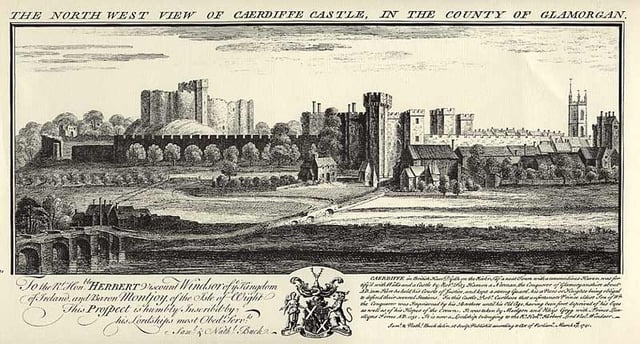
View of Caerdiffe Castle

The Norman keep
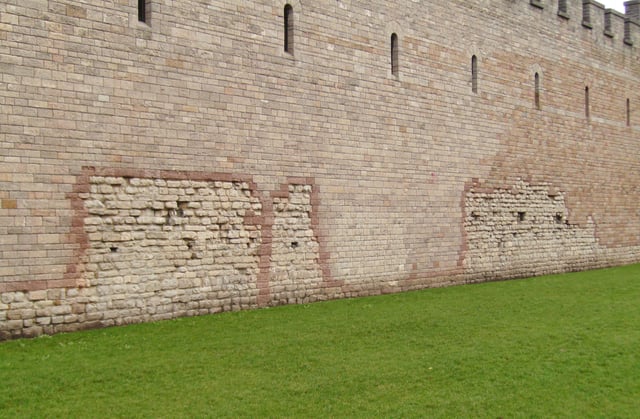
Front wall of Cardiff Castlepart of the original Roman fort
In 1081 William I, King of England, began work on the castle keep within the walls of the old Roman fort.[32] Cardiff Castle has been at the heart of the city ever since.[33] The castle was substantially altered and extended during the Victorian period by John Crichton-Stuart, 3rd Marquess of Bute, and the architect William Burges. Original Roman work can, however, still be distinguished in the wall facings.
A town grew up in the shadow of the castle, made up primarily of settlers from England.[34] Cardiff had a population of between 1,500 and 2,000 in the Middle Ages; a relatively normal size for a Welsh town in this period.[35] It was the centre of the Norman Marcher Lordship of Glamorgan and by the end of the 13th century, Cardiff was the only town in Wales with a population exceeding 2,000, although it remained relatively small compared with most notable towns in the England and continued to be very much contained within its walls, which has begun as a wooden palisade in the early 12th century.[36][37] It was of sufficient size and importance to be awarded a series of charters, notably in 1331 by William La Zouche, Lord of Glamorgan through marriage with the de Clare family,[38] Edward III in 1359,[39] then Henry IV in 1400,[39] and later Henry VI.
In 1404, Owain Glyndŵr burned Cardiff and took possession of the Castle.[37] As many buildings in the town were made of timber, and tightly packed together within the town walls, much of Cardiff was destroyed. Ironically given the treatment of Cardiff by Glyndwr, whose statue was erected in Cardiff Town Hall in the early twentieth century, reflecting the complex and often conflicting cultural identity Cardiff has as the capital of Wales, the town was soon rebuilt on the same street plan and began to flourish once again.[35] In addition to serving an important political role in the governance of the fertile south Glamorgan coastal plain, Cardiff was a busy port in the Middle Ages and was declared a staple port in 1327.
County town of Glamorganshire

John Speed's map of Cardiff from 1610
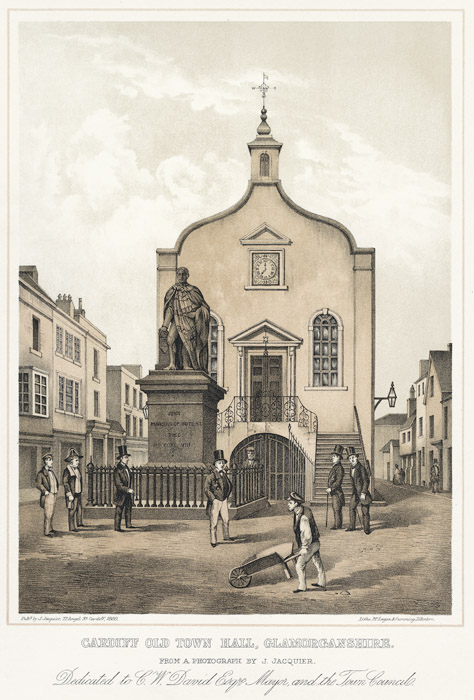
Cardiff old town hall (1860)
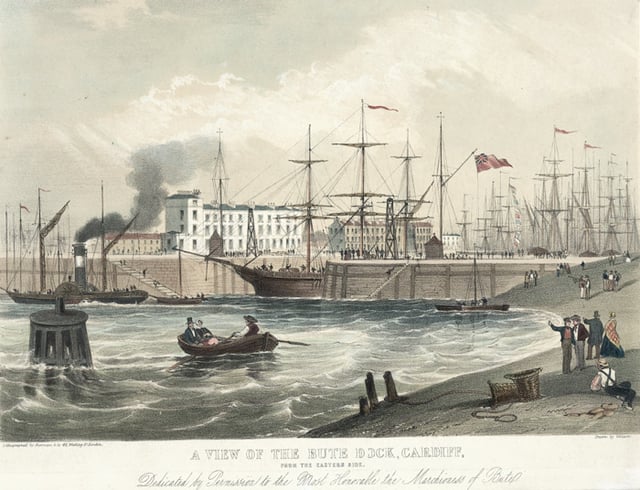
Jubilee dock, Cardiff, from the eastern side (1849)
In 1536, the Laws in Wales Acts 1535–1542 between England and Wales led to the creation of the shire of Glamorgan, and Cardiff was made the county town. It also became part of Kibbor hundred. Around this same time the Herbert family became the most powerful family in the area.[34] In 1538, Henry VIII closed the Dominican and Franciscan friaries in Cardiff, the remains of which were used as building materials.[35] A writer around this period described Cardiff: "The River Taff runs under the walls of his honours castle and from the north part of the town to the south part where there is a fair quay and a safe harbour for shipping."[35]
Cardiff had become a Free Borough in 1542[37] and further Royal Charters were granted to the town by Elizabeth I in 1600[40] and James I in 1608.[41] In 1573, it was made a head port for collection of customs duties.[34] Pembrokeshire historian George Owen described Cardiff in 1602 as "the fayrest towne in Wales yett not the welthiest.",[34] and the town gained a second Royal Charter in 1608.[42]
During the Second English Civil War, St Fagans just to the west of the town, played host to the Battle of St Fagans. The battle, between a Royalist rebellion and a New Model Army detachment, was a decisive victory for the Parliamentarians and allowed Oliver Cromwell to conquer Wales.[37] It is the last major battle to occur in Wales, with about 200 (mostly Royalist) soldiers killed.[34]
In the ensuing century Cardiff was at peace. In 1766, John Stuart, 1st Marquess of Bute married into the Herbert family and was later created Baron Cardiff,[34] and in 1778 he began renovations on Cardiff Castle.[45] In the 1790s a racecourse, printing press, bank and coffee house all opened, and Cardiff gained a stagecoach service to London. Despite these improvements, Cardiff's position in the Welsh urban hierarchy had declined over the 18th century. Iolo Morganwg called it "an obscure and inconsiderable place", and the 1801 census found the population to be only 1,870, making Cardiff only the 25th largest town in Wales, well behind Merthyr and Swansea.[46]
Building of the docks
In 1793, John Crichton-Stuart, 2nd Marquess of Bute was born. He would spend his life building the Cardiff docks and would later be called "the creator of modern Cardiff".[34] A twice-weekly boat service between Cardiff and Bristol was established in 1815,[45] and in 1821, the Cardiff Gas Works was established.[45]
After the Napoleonic Wars Cardiff entered a period of social and industrial unrest, starting with the trial and hanging of Dic Penderyn in 1831.[47]
The town grew rapidly from the 1830s onwards, when the Marquess of Bute built a dock, which eventually linked to the Taff Vale Railway. Cardiff became the main port for exports of coal from the Cynon, Rhondda, and Rhymney valleys, and grew at a rate of nearly 80% per decade between 1840 and 1870. Much of the growth was due to migration from within and outside Wales: in 1841, a quarter of Cardiff's population were English-born and more than 10% had been born in Ireland.[48] By the 1881 census, Cardiff had overtaken both Merthyr and Swansea to become the largest town in Wales.[49] Cardiff's new status as the premier town in South Wales was confirmed when it was chosen as the site of the University College South Wales and Monmouthshire in 1893.[46]
A permanent military presence was established in the town with the completion of Maindy Barracks in 1877.[50]
Cardiff faced a challenge in the 1880s when David Davies of Llandinam and the Barry Railway Company promoted the development of rival docks at Barry. Barry docks had the advantage of being accessible in all tides, and David Davies claimed that his venture would cause "grass to grow in the streets of Cardiff". From 1901 coal exports from Barry surpassed those from Cardiff, but the administration of the coal trade remained centred on Cardiff, in particular its Coal Exchange, where the price of coal on the British market was determined and the first million-pound deal was struck in 1907.[46] The city also strengthened its industrial base with the decision of the owners of the Dowlais Ironworks in Merthyr (who would later form part of Guest, Keen and Nettlefolds) to build a new steelworks close to the docks at East Moors, which Lord Bute opened on 4 February 1891.[51]
County Borough of Cardiff
Cardiff became a county borough on 1 April 1889, following the provisions of the Local Government Bill of 1888. The town had grown rapidly and had a population of more than 123,000. Cardiff retained its county borough status until 1974.[52]
City and capital city status
Welsh National War Memorial
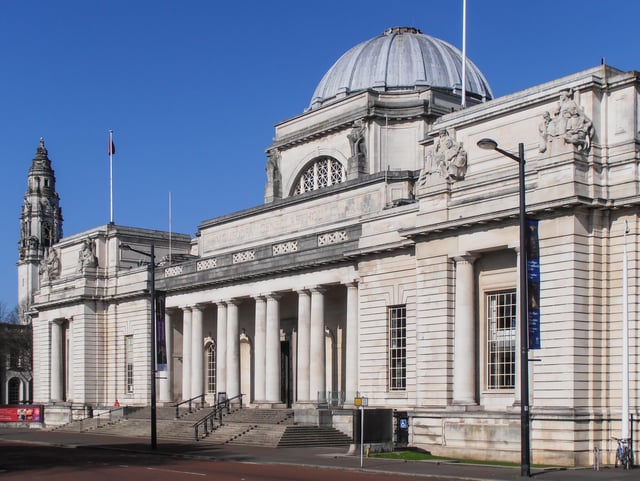
National Museum of Wales, Cardiff
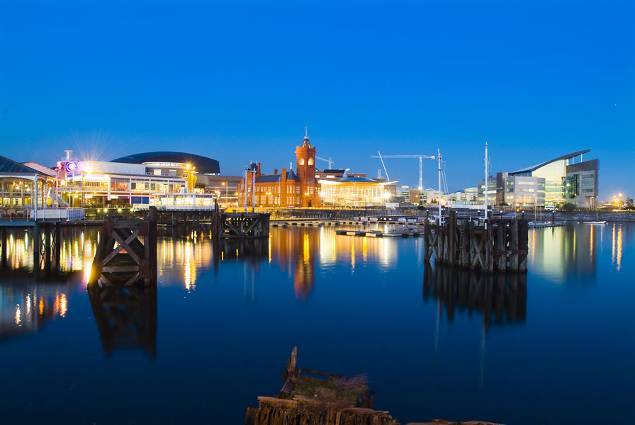
Redevelopment in the city's historic Cardiff Bay area
King Edward VII granted Cardiff city status on 28 October 1905,[53] and the city acquired a Roman Catholic Cathedral in 1916. In subsequent years an increasing number of national institutions were located in the city, including the National Museum of Wales, Welsh National War Memorial, and the University of Wales Registry Building – however, it was denied the National Library of Wales, partly because the library's founder, Sir John Williams, considered Cardiff to have "a non-Welsh population".[46]
After a brief post-war boom, Cardiff docks entered a prolonged decline in the interwar period. By 1936, their trade was less than half its value in 1913, reflecting the slump in demand for Welsh coal.[46] Bomb damage during the Cardiff Blitz in World War II included the devastation of Llandaff Cathedral, and in the immediate postwar years the city's link with the Bute family came to an end.
The city was recognised as the capital city of Wales on 20 December 1955, by a written reply by the Home Secretary Gwilym Lloyd George.[54] Caernarfon had also vied for this title.[55] Welsh local authorities had been divided on the issue of where a new capital of Wales should be, with only 76 out of 161 opting for Cardiff in a 1924 poll, organised by the South Wales Daily News.[56] Because of the divided opinion, discussions had not been revived on the issue until 1950, and Cardiff took steps to promote its 'Welshness'. The stalemate between Cardiff and Caernarfon (and Aberystwyth) wasn't broken until Cardiganshire County Council decided to support Cardiff and, in a new local authority vote, 134 out of 161 voted for the city.[56]
Cardiff therefore celebrated two important anniversaries in 2005. The Encyclopedia of Wales notes that the decision to recognise the city as the capital of Wales "had more to do with the fact that it contained marginal Conservative constituencies than any reasoned view of what functions a Welsh capital should have". Although the city hosted the Commonwealth Games in 1958, Cardiff only became a centre of national administration with the establishment of the Welsh Office in 1964, which later prompted the creation of various other public bodies such as the Arts Council of Wales and the Welsh Development Agency, most of which were based in Cardiff.
The East Moors Steelworks closed in 1978 and Cardiff lost population during the 1980s,[57] consistent with a wider pattern of counter urbanisation in Britain. However, it recovered and was one of the few cities (outside London) where population grew during the 1990s.[58] During this period the Cardiff Bay Development Corporation was promoting the redevelopment of south Cardiff; an evaluation of the regeneration of Cardiff Bay published in 2004 concluded that the project had "reinforced the competitive position of Cardiff" and "contributed to a massive improvement in the quality of the built environment", although it had failed "to attract the major inward investors originally anticipated".[59]
In the 1997 Welsh devolution referendum, Cardiff voters rejected the establishment of the National Assembly for Wales by 55.4% to 44.2% on a 47% turnout, which Denis Balsom partly ascribed to a general preference in Cardiff and some other parts of Wales for a 'British' rather than exclusively 'Welsh' identity.[60][61] The relative lack of support for the Assembly locally, and difficulties between the Welsh Office and Cardiff Council in acquiring the original preferred venue, Cardiff City Hall, encouraged other local authorities to bid to house the Assembly.[62][63] However, the Assembly eventually located at Tŷ Hywel in Cardiff Bay in 1999; in 2005, a new debating chamber on an adjacent site, designed by Richard Rogers, was opened.
Government

Cardiff City Hall in Cathays Park
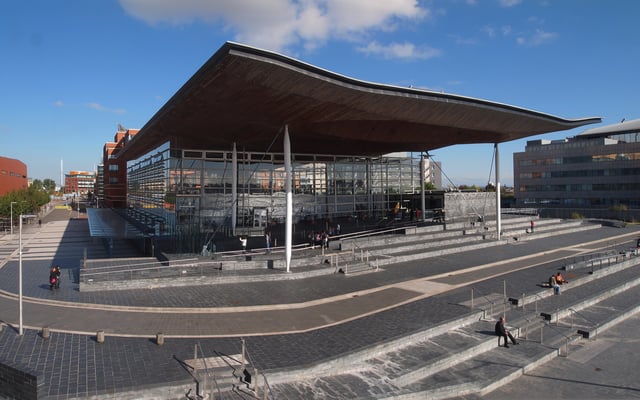
The Senedd, seat of the Welsh Assembly
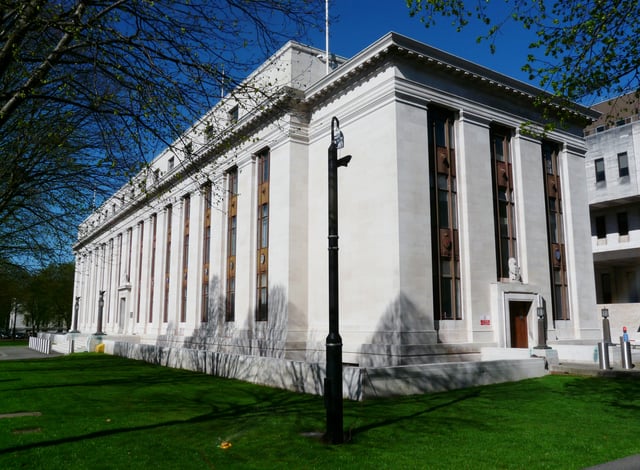
Crown Buildings are the Welsh Government's main offices in Cardiff
The National Assembly for Wales has been based in Cardiff Bay since its formation in 1999. The building, known as the Senedd (which translates into English as Legislature, Parliament or Senate) was opened on 1 March 2006, by The Queen.[64] The Assembly Members (AMs), the Assembly Commission and Ministerial support staff are based in Cardiff Bay. Cardiff elects four constituency Assembly Members (AMs) to the Assembly, with the individual constituencies for the Assembly being the same as for the UK Parliament. All of the city's residents have an extra vote for the South Wales Central region which increases proportionality to the Assembly. The most recent Welsh Assembly general election was held on 5 May 2016.
In the Assembly Cardiff is represented by Jenny Rathbone (Labour) in Cardiff Central, Julie Morgan (Labour) in Cardiff North, Vaughan Gething (Labour) in Cardiff South and Penarth and Mark Drakeford (Labour) in Cardiff West.
In Westminster, Cardiff is represented by Jo Stevens (Labour) in Cardiff Central, Anna McMorrin(Labour) in Cardiff North, Stephen Doughty (Labour) in Cardiff South and Penarth and Kevin Brennan (Labour) in Cardiff West.
The Welsh Government has its headquarters in Cardiff's Cathays Park where most of its civil servants are based, with smaller numbers in other locations in the city centre, Cathays, Canton, and Cardiff Bay.[65] There are other Welsh Government offices in other parts of Wales such as Llandudno and Aberystwyth and international offices throughout the world.[66]
Local government

Communities of Cardiff that have their own community council
Between 1889 and 1974 Cardiff was a county borough governed by Cardiff County Borough Council (known as Cardiff City Council after 1905). Between 1974 and 1996, Cardiff was governed by Cardiff City Council, a district council of South Glamorgan. Since local government reorganisation in 1996, Cardiff has been governed by the City and County Council of Cardiff, which is based at County Hall in Atlantic Wharf, Cardiff Bay. Voters elect 75 councillors every four years.
Between the 2004 and 2012 local elections, no individual political party held a majority on Cardiff County Council. The Liberal Democrats held the largest number of seats and Cllr Rodney Berman was Leader of the Council.[67] The Liberal Democrats and Plaid Cymru formed a partnership administration.[68] In the 2012 elections the Labour Party achieved an outright majority, after gaining an additional 33 seats across the city.
Cardiff is divided into communities. Several of these have their own community council, while the rest are governed solely by Cardiff City Council. Those with community councils are:
Lisvane
Old St Mellons
Pentyrch
Radyr and Morganstown
St Fagans
Tongwynlais
Geography
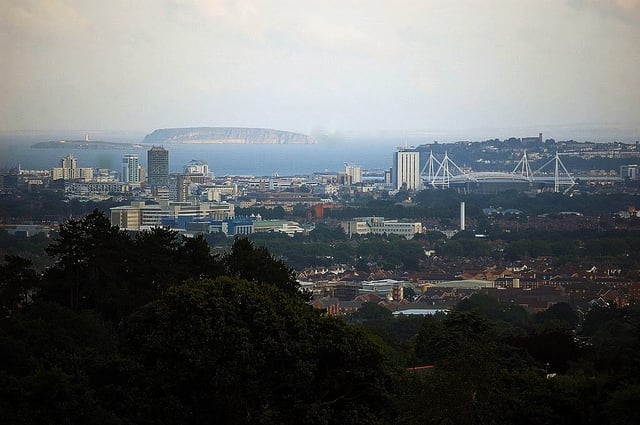
Looking south towards Cardiff city centre
The centre of Cardiff is relatively flat and is bounded by hills on the outskirts to the east, north and west. Its geographic features were influential in its development as the world's largest coal port, most notably its proximity and easy access to the coal fields of the South Wales Valleys. The highest point in the authority is Garth Hill 307 metres (1,007 feet) above sea level.
Cardiff is built on reclaimed marshland on a bed of Triassic stones; this reclaimed marshland stretches from Chepstow to the Ely Estuary,[69] which is the natural boundary of Cardiff and the Vale of Glamorgan. Triassic landscapes of this part of the world are usually shallow and low-lying which accounts and explains the flatness of the centre of Cardiff.[70] The classic Triassic marl, sand and conglomerate rocks are used predominantly throughout Cardiff as building materials. Many of these Triassic rocks have a purple complexion, especially the coastal marl found near Penarth. One of the Triassic rocks used in Cardiff is "Radyr Stone", a freestone which as its name suggests is quarried in the Radyr district.[71] Cardiff has also imported some materials for buildings: Devonian sandstones (the Old Red Sandstone) from the Brecon Beacons has been used. Most famously, the buildings of Cathays Park, the civic centre in the centre of the city, are built of Portland stone which was imported from Dorset.[72] A widely used building stone in Cardiff is the yellow-grey Liassic limestone rock of the Vale of Glamorgan, including the very rare "Sutton Stone", a conglomerate of lias limestone and carboniferous limestone.[73]
Cardiff is bordered to the west by the rural district of the Vale of Glamorgan – also known as The Garden of Cardiff – [74] to the east by the city of Newport, to the north by the South Wales Valleys and to the south by the Severn Estuary and Bristol Channel. The River Taff winds through the centre of the city and together with the River Ely flows into the freshwater lake of Cardiff Bay. A third river, the Rhymney flows through the east of the city entering directly into the Severn Estuary.
Cardiff is situated near the Glamorgan Heritage Coast, stretching westward from Penarth and Barry – commuter towns of Cardiff – with striped yellow-blue Jurassic limestone cliffs. The Glamorgan coast is the only part of the Celtic Sea that has exposed Jurassic (blue lias) geology. This stretch of coast, which has reefs, sandbanks and serrated cliffs, was a ship graveyard; ships sailing up to Cardiff during the industrial era often never made it as far as Cardiff as many were wrecked around this hostile coastline during west/south-westerly gales. Consequently, smuggling, deliberate shipwrecking and attacks on ships were common.[75]
Cityscape
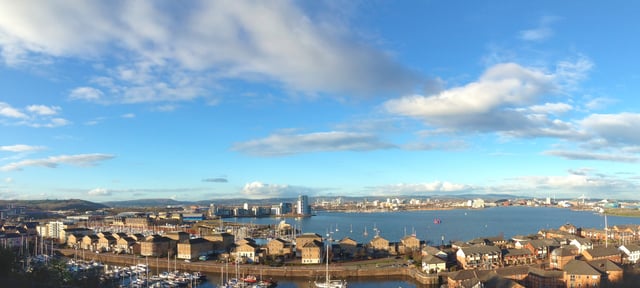
Overlooking Cardiff Bay, viewed from Penarth
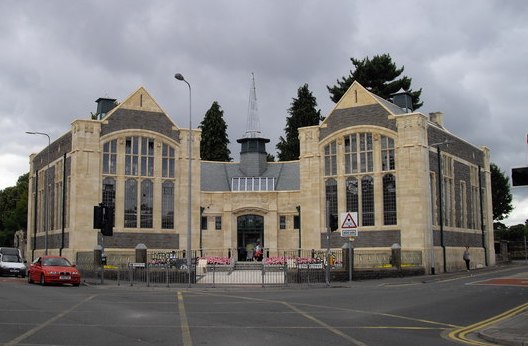
Cathays Library
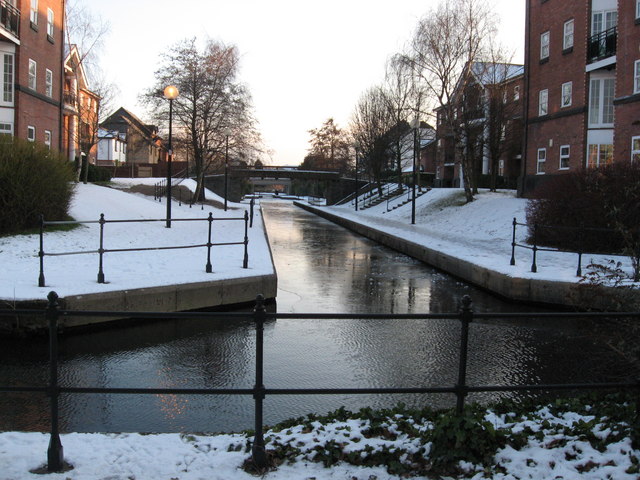
The dock feeder canalAtlantic Wharf
"Inner Cardiff" consists of the following wards: Plasnewydd, Gabalfa, Roath, Cathays, Adamsdown and Splott ward on the north and east of the city centre, and Butetown, Grangetown, Riverside and Canton to the south and west.[76] The inner-city areas to the south of the A4161 road (known as the "Southern Arc") are, with the exception of Cardiff Bay, some of the poorest districts of Wales with low levels of economic activity.[77] On the other hand, Gabalfa, Plasnewydd and Cathays north of the 'arc' have very large student populations,[78] and Pontcanna (situated north of Riverside and alongside Canton) is a favourite for students and young professionals. Penylan, which lies to the north east side of Roath Park, is an affluent area popular with those with older children and the retired.
To the west lie Ely, Caerau and Fairwater which contain some of the largest housing estates in the United Kingdom. With the exception of some of the outlying privately built estates at Michaelston-super-Ely and 1930s developments near Waun-Gron Road, this is an economically disadvantaged area with high numbers of unemployed households. Culverhouse Cross is a more affluent western area of the city. Heath, Birchgrove, Gabalfa, Mynachdy, Llandaff North, Llandaff, Llanishen, Radyr, Whitchurch & Tongwynlais, Rhiwbina, Thornhill, Lisvane and Cyncoed lie in an arc from the northwest to the northeast of the centre. Lisvane, Cyncoed, Radyr and Rhiwbina contain some of the more expensive housing in Wales.
Further to the east lie the wards of Pontprennau & Old St Mellons, Rumney, Pentwyn, Llanrumney and Trowbridge. The last three are again largely of public housing stock, although new private housing is being built in Trowbridge in considerable number. Pontprennau is the newest 'suburb' of Cardiff, whilst Old St Mellons has a history going back to the Norman Conquest in the 11th century.[79] The region that may be called "Rural Cardiff" contains the villages of St. Fagans, Creigiau, Pentyrch, Tongwynlais and Gwaelod-y-garth.[80] In 2017, plans were approved to create a new suburb of 7,000 homes between Radyr and St Fagans; known as Plasdŵr.[81] St. Fagans, home to the Museum of Welsh Life, is protected from further development.[82]
Climate
Cardiff lies within the north temperate zone and has an essentially maritime climate (Köppen: Cfb), characterised by mild weather that is often cloudy, wet and windy.[85] Summers tend to be warm and sunny, with average maximum temperatures between 19 and 22 °C (66 and 72 °F). Winters tend to be fairly wet, but rainfall is rarely excessive and the temperature usually stays above freezing. Spring and autumn feel quite similar and the temperatures tend to stay above 14 °C (57 °F) – also the average annual daytime temperature. Rain is unpredictable at any time of year, although the showers tend to be shorter in summer.[86]
Cardiff experiences less rainfall than the average for Wales. Rain falls in Cardiff on 146 days during an average year, with total annual rainfall of 1,151.9 millimetres (45.35 in). Monthly rainfall pattern shows that from October to January average monthly rainfall in Cardiff exceeded 100 millimetres (3.9 in) each month, the wettest month being December with 125.3 millimetres (4.93 in). Cardiff's driest months are from April to June, with average monthly rainfall fairly consistent, at between 65 and 75 millimetres (2.6 and 3.0 in).[89][90]
| Climate data for Cardiff, elevation: 0 m (0 ft), 1981–2010 normals, extremes 1960–present | |||||||||||||
|---|---|---|---|---|---|---|---|---|---|---|---|---|---|
| Month | Jan | Feb | Mar | Apr | May | Jun | Jul | Aug | Sep | Oct | Nov | Dec | Year |
| Record high °C (°F) | 13.8 (56.8) | 15.0 (59.0) | 19.5 (67.1) | 24.0 (75.2) | 26.6 (79.9) | 32.1 (89.8) | 33.6 (92.5) | 34.5 (94.1) | 27.0 (80.6) | 24.6 (76.3) | 17.1 (62.8) | 16.7 (62.1) | 33.5 (92.3) |
| Average high °C (°F) | 8.3 (46.9) | 8.6 (47.5) | 11.1 (52.0) | 13.8 (56.8) | 17.1 (62.8) | 19.8 (67.6) | 21.7 (71.1) | 21.5 (70.7) | 18.8 (65.8) | 14.9 (58.8) | 11.3 (52.3) | 8.7 (47.7) | 14.7 (58.5) |
| Daily mean °C (°F) | 5.3 (41.5) | 5.4 (41.7) | 7.6 (45.7) | 9.5 (49.1) | 12.7 (54.9) | 15.4 (59.7) | 17.4 (63.3) | 17.2 (63.0) | 14.7 (58.5) | 11.3 (52.3) | 8.0 (46.4) | 5.7 (42.3) | 10.9 (51.6) |
| Average low °C (°F) | 2.3 (36.1) | 2.1 (35.8) | 4.0 (39.2) | 5.2 (41.4) | 8.3 (46.9) | 11.0 (51.8) | 13.1 (55.6) | 12.8 (55.0) | 10.5 (50.9) | 7.7 (45.9) | 4.6 (40.3) | 2.6 (36.7) | 7.0 (44.6) |
| Record low °C (°F) | −10.3 (13.5) | −8.8 (16.2) | −8.1 (17.4) | −4.8 (23.4) | −2.0 (28.4) | 1.0 (33.8) | 5.3 (41.5) | 3.6 (38.5) | 2.4 (36.3) | −2.7 (27.1) | −8.4 (16.9) | −8.8 (16.2) | −10.3 (13.5) |
| Average precipitation mm (inches) | 121.6 (4.79) | 85.2 (3.35) | 89.8 (3.54) | 68.6 (2.70) | 72.3 (2.85) | 66.6 (2.62) | 78.4 (3.09) | 93.4 (3.68) | 94.0 (3.70) | 133.5 (5.26) | 123.4 (4.86) | 125.3 (4.93) | 1,151.9 (45.35) |
| Average precipitation days(≥ 1.0 mm) | 15.7 | 11.1 | 13.0 | 11.1 | 11.2 | 10.1 | 10.7 | 11.0 | 11.0 | 15.5 | 14.5 | 13.9 | 148.6 |
| Mean monthly sunshine hours | 54.4 | 75.9 | 111.9 | 169.6 | 190.6 | 190.0 | 199.0 | 190.7 | 149.6 | 103.0 | 65.8 | 48.9 | 1,549.4 |
| Source #1: Met Office[91][92][93] | |||||||||||||
| Source #2: KNMI[94] | |||||||||||||
Demography
Residential areas of northern Cardiff
| Historical population | ||
|---|---|---|
| Year | Pop. | ±% |
| 1801 | 6,342 | — |
| 1851 | 26,630 | +319.9% |
| 1861 | 48,965 | +83.9% |
| 1871 | 71,301 | +45.6% |
| 1881 | 93,637 | +31.3% |
| 1891 | 142,114 | +51.8% |
| 1901 | 172,629 | +21.5% |
| 1911 | 209,804 | +21.5% |
| 1921 | 227,753 | +8.6% |
| 1931 | 247,270 | +8.6% |
| 1941 | 257,112 | +4.0% |
| 1951 | 267,356 | +4.0% |
| 1961 | 278,552 | +4.2% |
| 1971 | 290,227 | +4.2% |
| 1981 | 274,500 | −5.4% |
| 1991 | 272,557 | −0.7% |
| 2001 | 292,150 | +7.2% |
| 2011 | 346,100 | +18.5% |
| 2017 | 362,756 | +4.8% |
| Source: Vision of Britain [243] except 2011, which is the 2011 census data from the Office for National Statistics [244] . Historical populations are calculated with the modern boundaries | ||
Following a period of decline during the 1970s and 1980s, Cardiff's population is growing. The local authority area had a population of 346,100 at the 2011 census,[95] compared to a 2001 Census figure of 305,353.[96] Between mid −2007 and mid–2008, Cardiff was the fastest-growing local authority in Wales with population growth rate of 1.2%.[97] According to Census 2001 data, Cardiff was the 21st largest urban area.[98] The Cardiff Larger Urban Zone (a Eurostat definition including the Vale of Glamorgan and a number of local authorities in the Valleys) has 841,600 people, the 10th largest LUZ in the UK.[99] The Cardiff and South Wales Valleys metropolitan area has a population of nearly 1.1 million people.[100]
Official estimates derived from the census regarding the city's total population have been disputed. The city council has published two articles that argue the 2001 census seriously under reports the population of Cardiff and, in particular, the ethnic minority population of some inner city areas.[101][102]
The Welsh Government's official mid year estimate of the population of the Cardiff local authority area in 2017 was 362,756.[5] At the time of the 2011 census the official population of the Cardiff Built Up Area was estimated to be 447,287.[103][104] The BUA is not contiguous with the local authority boundary and aggregates data at a lower level; for Cardiff this includes: urban part of Cardiff, Penarth/Dinas Powys, Caerphilly and Pontypridd.
Cardiff has an ethnically diverse population due to its past trading connections, post-war immigration and the large numbers of foreign students who attend university in the city. The ethnic make-up of Cardiff's population at the time of the 2011 census was: 84.7% White, 1.6% mixed White and Black African/Caribbean, 0.7% mixed White and Asian, 0.6% mixed other, 8.1% Asian, 2.4% Black, 1.4% Arab and 0.6% other ethnic groups.[4] This means that almost 53,000 people from a non-white ethnic group reside in the city. This diversity, and especially that of the city's long-established African[105] and Arab[106] communities, has been celebrated in a number of cultural exhibitions and events, along with a number of books which have been published on this subject.[107][108]
Health
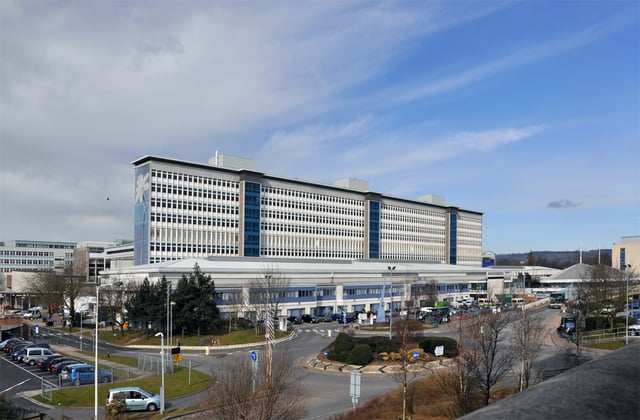
University Hospital of Wales
There are seven NHS hospitals in the city, the largest of which is the University Hospital of Wales. The University Hospital of Wales is the third largest hospital in the UK and deals with most accidents and emergencies.[109] The University Dental Hospital, which provides emergency dental treatment, is also located on this site. Llandough Hospital is located in the south of the city.
St. David's Hospital, the city's newest hospital, built behind the former building, is located in Canton and provides services for the elderly and children. Cardiff Royal Infirmary is located on Newport Road, near the city centre. The majority of this hospital was closed in 1999 but with the West Wing remaining open for clinic services, genitourinary medicine and rehabilitation treatment. Rookwood Hospital and the Velindre Cancer Centre are also located within Cardiff. They are administered by the Cardiff and Vale University Health Board, with the exception of Velindre, which is run by a separate trust.[110][111] Spire Healthcare, a private hospital, is in Pentwyn.[112]
Language
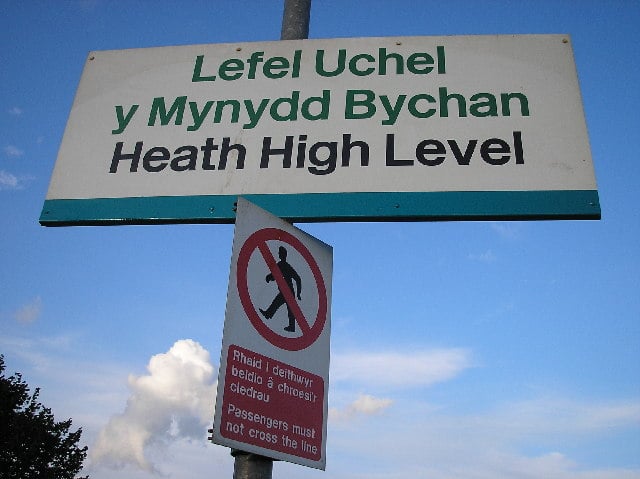
Bilingual signs are commonplace in Cardiff.
Cardiff has a chequered linguistic history with Welsh, English, Latin, Norse and Norman French preponderant at different times. Welsh was the majority language in Cardiff from the 13th century until the city's explosive growth in the Victorian era.[113] As late as 1850, five of the 12 Anglican churches within the current city boundaries conducted their services exclusively in the Welsh language, while only two worshipped exclusively in English.[113] By 1891, the percentage of Welsh speakers had dropped to 27.9% and only Lisvane, Llanedeyrn and Creigiau remained as majority Welsh-speaking communities.[114] The Welsh language became grouped around a small cluster of chapels and churches, the most notable of which is Tabernacl in the city centre, one of four UK churches chosen to hold official services to commemorate the new millennium.
Following the establishment of the city's first Welsh School (Ysgol Gymraeg Bryntaf) in the 1950s, Welsh has regained ground.[115] Aided by Welsh-medium education and migration from other parts of Wales, there has been a significant increase in the number and percentage of Welsh speakers, with numbers doubling in the 20 years between the 1991 and 2011 censuses, from 18,071 (6.6%) to 36,735 (11.1%) residents aged three years and above.[116] The LSOA (Lower Layer Super Output Area) with the highest percentage of Welsh speakers in the city-centre is found in Canton, at 25.5%.[117] The LSOA with the highest percentage of Welsh speakers in the entirety of Cardiff is found in Whitchurch at 26%.[117]
Cardiff City Council adopted a 5-year Welsh language strategy in 2017 in order to increase the number of Welsh speakers (aged 3+) in Cardiff by 15.9%, from 36,735 in 2011 to 42,584 residents by the 2021 Census.[118] The ONS estimated as of June 2018, 75,600 (21.8%) of Cardiff's population could speak Welsh.[119]
In addition to English and Welsh, the diversity of Cardiff's population (including foreign students) means that a large number of languages are spoken within the city. One study has found that Cardiff has speakers of at least 94 languages, with Somali, Urdu, Bengali and Arabic being the most commonly spoken foreign languages.[120]
The modern Cardiff accent is distinct from that of the nearby South Wales Valleys. It is marked primarily by:
Language schools
Due to its diversity, large student population, and convenient size and location, Cardiff has seen a rise in the number of people coming to the city to learn English. Foreign students coming from Arab states and other European countries are a common sight on the streets of Cardiff.[97] The British Council has an office in the city centre and there are six accredited schools in the area.[123]
Religion
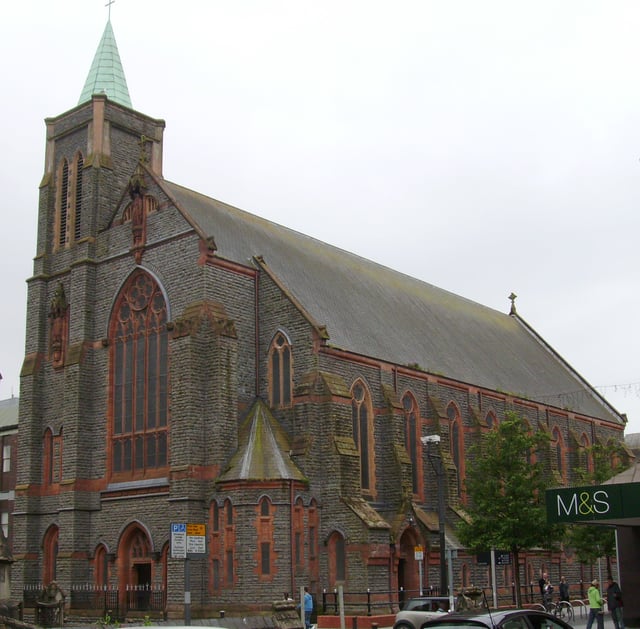
Cardiff Metropolitan Cathedral
Llandaff Cathedral, an Anglican cathedral, the parish church of Llandaff, the seat of the Bishop of Llandaff, the head of the Church in Wales

Sri Dasmais Singh Sabha Gurdwara, Bhatra Sikh Centre in Riverside.
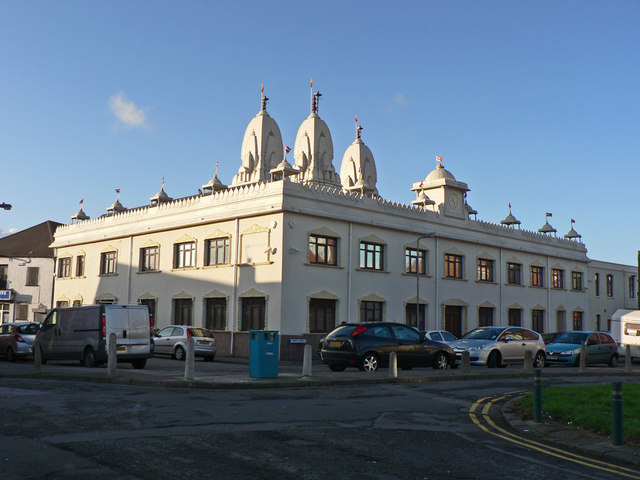
Shri Swaminarayan Mandir in Riverside was the first Hindu temple in Wales. It is also the largest in Wales.
Since 1922, Cardiff has included Llandaff within its boundary, and therefore Llandaff Cathedral, an Anglican cathedral, the parish church of Llandaff and the seat of the Bishop of Llandaff, the head of the Church in Wales Diocese of Llandaff.
There is a Roman Catholic cathedral in the city. Since 1916, Cardiff has been the seat of a Catholic archbishop, but there appears to have been a fall in the estimated Catholic population, with estimated numbers in 2006 being around 25,000 fewer than in 1980.[124] Likewise, the Jewish population of the city also appears to have fallen – there are two synagogues in Cardiff, one in Cyncoed and one in Moira Terrace, as opposed to seven at the turn of the 20th century.[125] There are a significant number of nonconformist chapels, an early 20th century Greek Orthodox church and 11 mosques.[126][127][128] In the 2001 census 66.9% of Cardiff's population described itself as Christian, a percentage point below the Welsh and UK averages.
The oldest of the non-Christian communities in Wales is Judaism. Jews were not permitted to live in England and Wales between the 1290 Edict of Expulsion – given by Edward I of England – and the 17th century. A Welsh Jewish community was re-established in the 18th century.[129] There was once a fairly substantial Jewish population in South Wales, most of which has disappeared. The Cardiff Jewish community congregations are consolidated in the present, modern building in Cyncoed Gardens, dedicated by Chief Rabbi Jonathan Sacks in 2003.[130] Educational options for Jewish adults are expanding in Cardiff via courses offered by Rabbi Michoel Rose and The Rohr Jewish Learning Institute.[131]
In the 2001 census Cardiff's Muslim population stood at 3.7%, above the UK average (2.7%) and significantly above the Welsh average. Cardiff has one of the longest-established Muslim populations in the UK, started by Yemeni sailors who settled in the city during the 19th century.[132] Cardiff is now home to over 11,000 Muslims from many different nationalities and backgrounds,[133] nearly 52% of the Welsh Muslim population.[134]
The proportion of Cardiff residents declaring themselves to be Hindu, Sikh and Jewish were all considerably higher than the Welsh averages, but less than the UK figures. The city has been home to a sizable Hindu community since Indian immigrants settled there during the 1950s and 1960s. The first Hindu temple in the city was opened in Grangetown on 6 April 1979 on the site of an abandoned printing press (which itself was the former site of a synagogue).[135] The 25th anniversary of the temple's founding was celebrated in September 2007 with a parade of over 3000 people through the city centre, including Hindus from across the United Kingdom and members of Cardiff's other religious communities.[136] Today, there are over 2000 Hindus in Cardiff, worshiping at three temples across the city.[133]
In the 2001 census 18.8% of the city's population stated they had no religion, while 8.6% did not state a religion.[137]
Economy
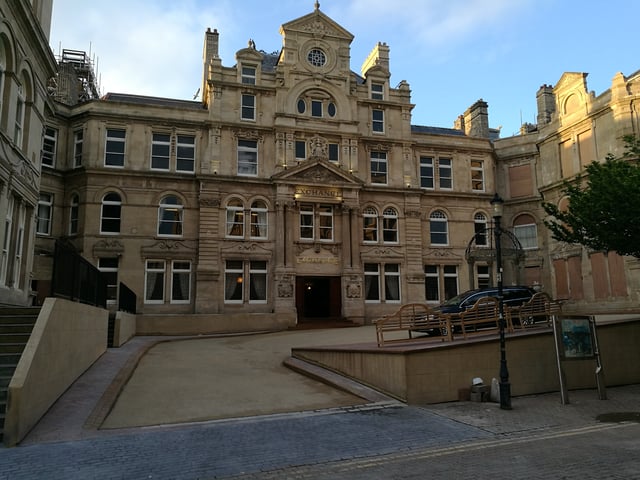
The Coal Exchange

Callaghan Square is a major commercial development in central Cardiff
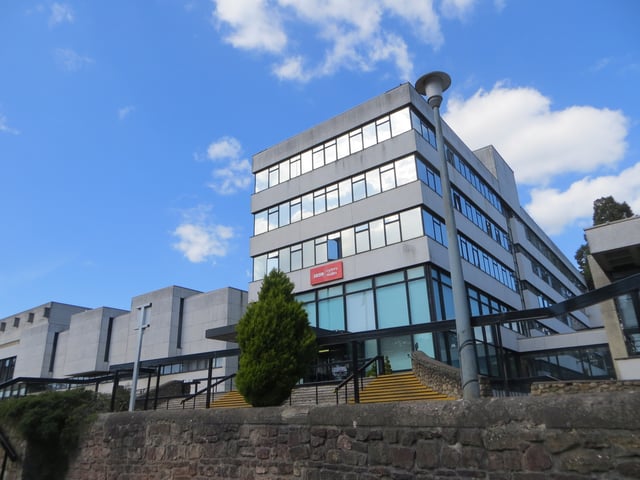
BBC Broadcasting House
As the capital city of Wales, Cardiff is the main engine of growth in the Welsh economy. Though the population of Cardiff is about 10% of the Welsh population, the economy of Cardiff makes up nearly 20% of Welsh GDP and 40% of the city's workforce are daily in-commuters from the surrounding south Wales area.[138][139]
Industry has played a major part in Cardiff's development for many centuries. The main catalyst for its transformation from a small town into a big city was the demand for coal required in making iron and later steel, brought to the sea by packhorse from Merthyr Tydfil. This was first achieved by the construction of a 25-mile (40 km) long canal from Merthyr (510 feet above sea-level) to the Taff Estuary at Cardiff.[140] Eventually the Taff Vale Railway replaced the canal barges and massive marshalling yards sprang up as new docks were developed in Cardiff – all prompted by the soaring worldwide demand for coal from the South Wales valleys. At its peak, Cardiff's port area, known as Tiger Bay, became the busiest port in the world and – for some time – the world's most important coal port.[141][142] In the years leading up to the First World War, more than 10 million tonnes of coal was exported annually from Cardiff Docks.[143] In 1907, Cardiff's Coal Exchange was the first host to a business deal for a million pounds Sterling.[144] After a period of decline, Cardiff's port has started to grow again – over 3 million tonnes of cargo passed through the docks in 2007.[145]
Today, Cardiff is the principal finance and business services centre in Wales, and as such there is a strong representation of finance and business services in the local economy. This sector, combined with the Public Administration, Education and Health sectors, have accounted for around 75% of Cardiff's economic growth since 1991.[146] The city was recently placed seventh overall in the top 50 European cities in the fDI 2008 Cities of the Future list published by the fDi magazine, and also ranked seventh in terms of attracting foreign investment.[147] Notable companies such as Legal & General, Admiral Insurance, HBOS, Zurich, ING Direct, The AA, Principality Building Society, 118118, British Gas, Brains, SWALEC Energy and BT, all operate large national or regional headquarters and contact centres in the city, some of them based in Cardiff's office towers such as Capital Tower and Brunel House. Other major employers include NHS Wales and the National Assembly for Wales. On 1 March 2004, Cardiff was granted Fairtrade City status.
Cardiff is one of the most popular tourist destination cities in the United Kingdom, receiving 18.3 million visitors in 2010 and generating £852 million for the city's economy.[148] One result of this is that one in five employees in Cardiff is based in the distribution, hotels and restaurants sector, highlighting the growing retail and tourism industries in the city.[146] There are a large number of hotels of varying sizes and standards in the city, providing almost 9,000 available bed spaces.[149]
Cardiff is home to the Welsh media and a large media sector with BBC Wales, S4C and ITV Wales all having studios in the city.[150] In particular, there is a large independent TV production industry sector of over 600 companies, employing around 6000 employees and with a turnover estimated at £350 m.[150] Just to the north west of the city, in Rhondda Cynon Taff, the first completely new film studios in the UK for 30 years are being built, named Valleywood. The studios are set to be the biggest in the UK. In 2011 the BBC completed the Roath Lock studios in Cardiff Bay to film dramas such as Casualty, Doctor Who, and Pobol y Cwm.[151]
Cardiff has several regeneration projects such as the St David's 2 Centre and surrounding areas of the city centre, and the £1.4 billion International Sports Village in Cardiff Bay which played a part in the London 2012 Olympics. It features the only Olympic-standard swimming pool in Wales, the Cardiff International Pool, which opened on 12 January 2008.
According to the Welsh Rugby Union, the Principality Stadium has contributed £1 billion to the Welsh economy in the ten years after it opened in 1999, with around 85% of that amount staying in the Cardiff area.[152]
Shopping
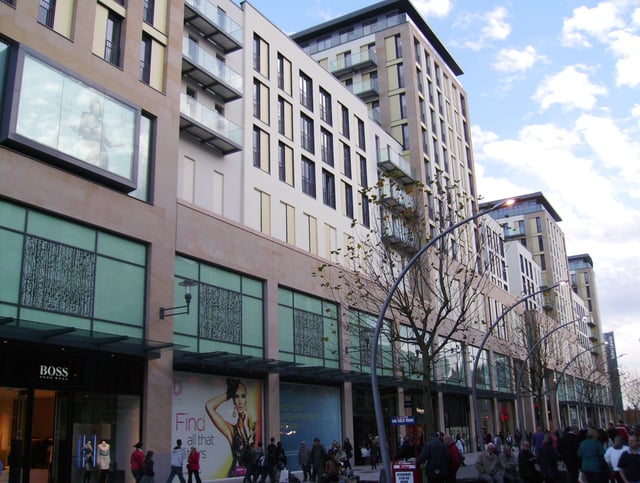
St. David's is the largest shopping centre in Wales.
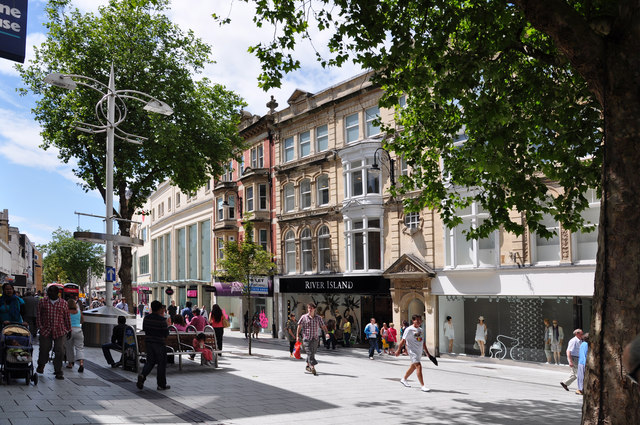
Queen Street, one of Cardiff's main shopping areas
The majority of Cardiff's shopping portfolio is in the city centre around Queen Street and St. Mary Street, with large suburban retail parks located in Cardiff Bay, Culverhouse Cross, Leckwith, Newport Road and Pontprennau, together with markets in the city centre and Splott. A major £675 million regeneration programme for Cardiff's St. David's Centre was completed in 2009, which has provided a total of 1,400,000 square feet (130,000 m2) of shopping space, making it one of the largest shopping centres in the United Kingdom.[153] The centre was named the international shopping centre of the year in 2010 by Retail Leisure International (RLI).[154]
The Castle Quarter is a commercial area in the north of the city centre which includes some of Cardiff's Victorian and Edwardian arcades: Castle Arcade, High Street Arcade and Duke Street Arcade, and principal shopping streets: St Mary Street, High Street, Castle Street and Duke Street. Development of the area began in February 2010 and is expected to be completed by July 2011. Cardiff Council says that work to create the Castle Quarter as a pedestrian friendly environment for High Street and St Mary Street is designed to enhance the city centre.[155]
Transport
Rail
Cardiff Central railway station is the largest railway station in Wales with nine platforms, through which over 12.5 million passengers a year pass.[156][157] It provides direct services to Bridgend and Newport; long-distance, cross-Wales services to Wrexham, Holyhead, Bristol, Birmingham, Manchester and London.
Cardiff Queen Street railway station is the second-busiest in Wales and is the hub for routes via the Valley Lines services that connect the South Wales Valleys and the Cardiff suburbs with the city centre on the former site of Temperance Town. It is located at the eastern end of the city centre, and also provides services to Cardiff Bay. Cardiff has a suburban rail system known as the Valleys & Cardiff Local Routes, which is operated by Transport for Wales. There are eight lines which serve 20 stations in the city, 26 in the wider urban area (including Taffs Well, Penarth and Dinas Powys) and more than 60 in the South Wales valleys and the Vale of Glamorgan.[158]
Air

Cardiff Airport
Domestic and international air links to Cardiff and South & West Wales are provided from Cardiff Airport (CWL), the only international airport in Wales. The airport is situated in the village of Rhoose, 10 miles (16 km) west of the city. There are regular bus services linking the airport with the Cardiff Central bus station as well as a train service from Rhoose Cardiff International Airport railway station to Cardiff Central.
Road and bus
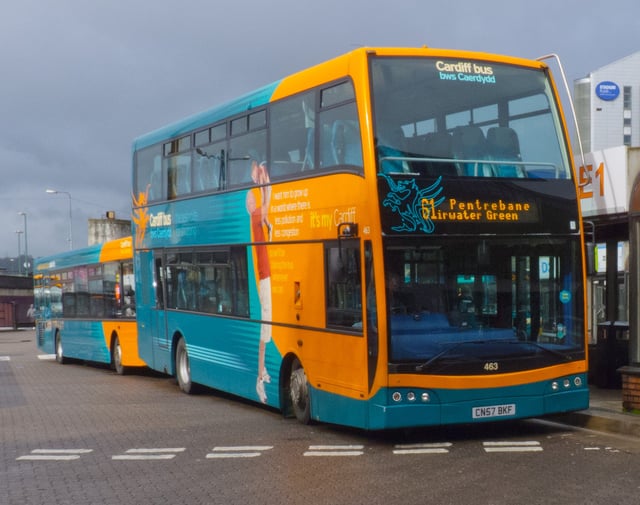
Cardiff Bus has the most bus services operating in the Cardiff area.
The M4 motorway connects Cardiff with Swansea to the west, and Newport and London to the east, with four junctions on the M4 including the one with the A48(M). The A470 provides an important link from the city to the Heads of the Valleys road. When completed, the A4232—also known as the Peripheral Distributor Road— will form part of the Cardiff ring-road system along with the M4 motorway between junctions 30 and 33.[159]
Cardiff has a comprehensive bus network, with providers including municipal bus company Cardiff Bus (routes within the city and to Newport, Barry and Penarth), NAT Group (cross-city and to Cardiff Airport), Stagecoach South Wales (to the South Wales Valleys) and First Cymru (to Cowbridge and Bridgend). National Express and Megabus provides direct services to major cities such as Bristol, London, Newcastle upon Tyne and Manchester
Cycle
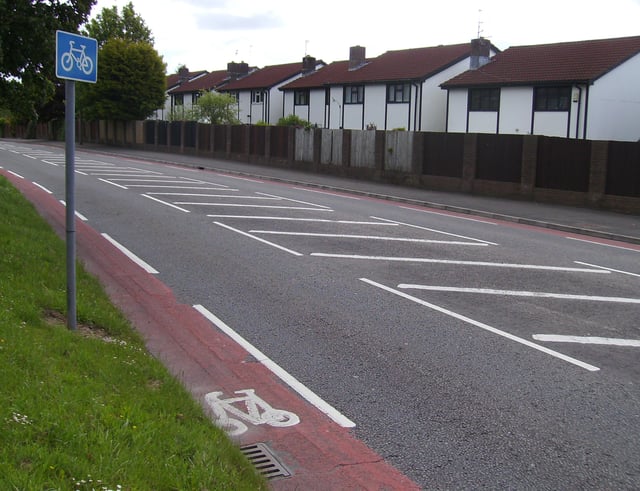
Typical cycle lane in Cardiff
The Taff Trail is a walking and cycle path running for 55 miles (88.5 km) between Cardiff Bay and Brecon in the Brecon Beacons National Park. It runs through Bute Park, Sophia Gardens and many other green areas within Cardiff. It is possible to cycle the entire distance of the Trail almost completely off-road, as it largely follows the River Taff and many of the old disused railways of the Glamorganshire valleys. On Sundays in summer the Beacons Bike Bus enables cyclists to take their bikes into the Beacons and then ride back to Cardiff along the Trail.[160]
Nextbike have operated a public bike hire scheme in the city since March 2018.[161]
Water
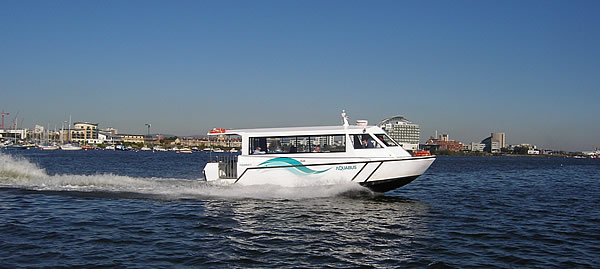
Aquabus
The Aquabus water taxi runs every hour between the city centre (Taff Mead Embankment) and Cardiff Bay (Mermaid Quay), and between Cardiff Bay and Penarth Cardiff Bay Barrage. Throughout the year, Cardiff Waterbus [162] sail between the Pierhead on The Waterfront and the Penarth end of the Cardiff Bay Barrage with short sightseeing cruises.
Between March and October boats depart from Cardiff Bay to take visitors to Flat Holm Island. The PS Waverley and MV Balmoral sail from Britannia Quay (in Roath Basin) to various destinations in the Bristol Channel.
Telecommunications
029 is the current telephone dialling code for Cardiff, as well as for the neighbouring towns of Penarth, Dinas Powys and Caerphilly. The dialling code is optional when dialling within the area, with it being possible to dial between any two phones within the 029 code using only the eight-digit local number.
Prior to the Big Number Change on 22 April 2000 the area had shorter, six-digit local numbers with an area code of 01222 (with 0222 preceding this, prior to May 1995). There remains a common misconception that local numbers are still six digits long and that the code is 02920, despite the existence of newer Cardiff numbers in the ranges (029) 21xx xxxx and (029) 22xx xxxx.
Education
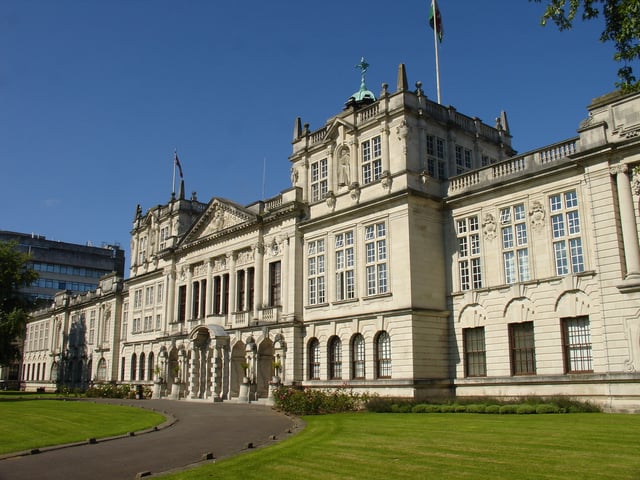
Cardiff University's main building
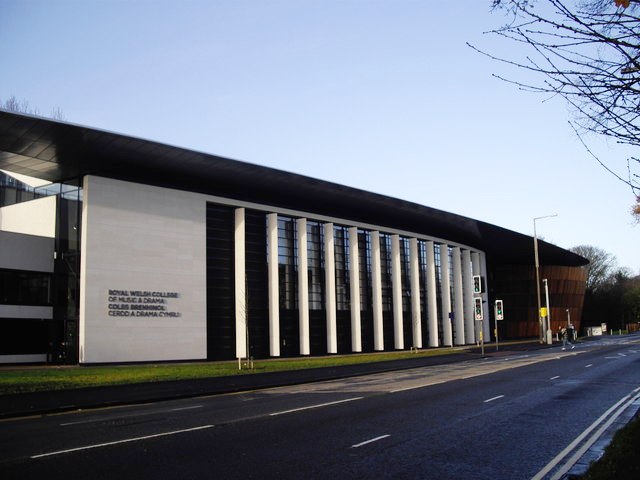
Royal Welsh College of Music & Drama
Cardiff is home to four major institutions of higher education: Cardiff University, Cardiff Metropolitan University, University of South Wales and the Royal Welsh College of Music & Drama.
Cardiff University was founded by a royal charter in 1883 as the University College of South Wales and Monmouthshire,[163] is a member of the Russell Group of leading research led universities, having most of its campus in Cathays and the city centre. Cardiff Metropolitan University (formerly UWIC) has campuses in the Llandaff, Cyncoed and city centre areas, and is part of the confederal University of Wales. The Royal Welsh College of Music & Drama is a conservatoire established in 1949 and is based in the grounds of Cardiff Castle. The University of South Wales's Cardiff campus, Atrium, is home to the Cardiff School of Creative & Cultural Industries and is located in the city centre.
The total number of higher education students in the city is around 43,900.[164][165] The city also has two further education colleges: Cardiff and Vale College and St David's College. The former is the result of a merger, completed in August 2011, between Coleg Glan Hafren and Barry College. Further education is also offered at most high schools in the city.
Cardiff has three state nursery schools (one bilingual), 98 state primary schools (two bilingual, fifteen Welsh medium), and 19 state secondary schools (three Welsh medium).[166] There are also a number of independent schools in the city, including St John's College, Llandaff Cathedral School, Cardiff Sixth Form College, Kings Monkton and Howell's School, a single-sex girls' school (until sixth form). In 2013 Cardiff Sixth Form College came top of the independent senior schools in the UK, which were based on the percentage of A* and A at Advanced Level. Also in the top 100 were St John's College and Howell's School.[167]
As well as academic institutions, Cardiff is also home to other educational and learning organisations such as Techniquest, a hands-on science discovery centre that now has franchises throughout Wales, and is part of the Wales Gene Park in collaboration with Cardiff University, NHS Wales and the Welsh Development Agency (WDA).[170] Cardiff is also home of the largest regional office of the International Baccalaureate Organisation (IBO). This office is home to the organisation's curriculum and assessment centre, which is responsible for overseeing the creation and grading of various IBDP assessments.
Landmarks and attractions
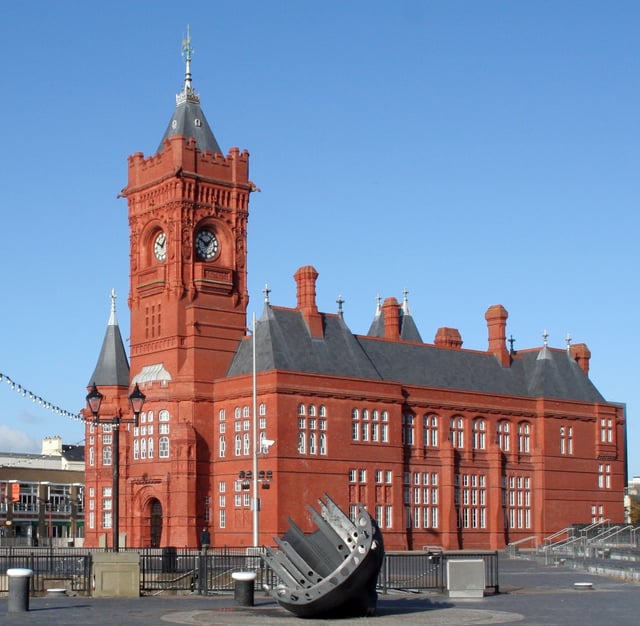
Pierhead Building
Cardiff has many landmark buildings such as the Principality Stadium, Pierhead Building the Welsh National Museum and the Senedd, the home of the National Assembly for Wales. Cardiff is also famous for Cardiff Castle, St David's Hall, Llandaff Cathedral and the Wales Millennium Centre.
Cardiff Castle is a major tourist attraction in the city and is situated in the heart of the city centre. The National History Museum at St Fagans in Cardiff is a large open-air museum housing dozens of buildings from throughout Welsh history that have been moved to the site in Cardiff. The Civic Centre in Cathays Park comprises a collection of Edwardian buildings such as the City Hall, National Museum and Gallery of Wales, Cardiff Crown Court, and buildings forming part of Cardiff University, together with more modern civic buildings. These buildings are laid out around the Queen Alexandra Gardens, a formal park which contains the Welsh National War Memorial and a number of other, smaller, memorials.
In addition to Cardiff Castle, Castell Coch (Red Castle) is located in Tongwynlais, in the north of the city. The current castle is an elaborately decorated Victorian folly designed by William Burges for the Marquess and built in the 1870s, as an occasional retreat. However, the Victorian castle stands on the footings of a much older medieval castle possibly built by Ifor Bach, a regional baron with links to Cardiff Castle also. The exterior has become a popular location for film and television productions. It rarely fulfilled its intended role as a retreat for the Butes, who seldom stayed there. For the Marquess, the pleasure had been in its creation, a pleasure lost following Burges's death in 1881.
Cardiff claims to have the largest concentration of castles of any city in the world.[171] As well as Cardiff Castle and Castell Coch, there are the remains of two Motte and Bailey castles in Radyr and Rhiwbina (both known as the "Twmpath", a Welsh word for a small mound),[172] which along with a castle at Whitchurch (known as Treoda and destroyed by housing in the 1960s) formed an arc of fortifications which divided the Norman lordship from the Welsh lordship of Senghenydd.[173] Further up the Cefn Cibwr ridge on the boundary with Caerphilly there is also another ruined castle, known as Castell Morgraig. Archaeological evidence suggests this castle was never finished, and it is debated whether the fortification was of Norman or Welsh origin. The concentration of these castles is indicative of the moveable nature of the border between the Norman lordship of Glamorgan, centred at Cardiff, and its Welsh neighbours to the north.
While not strictly castles in the historic sense, there is also the ruined Llandaff Bishop's Palace, a fortified residence belonging to the Bishops of Llandaff and Saint Fagans Castle, a preserved seventeenth century manor house, once the seat of the Earls of Plymouth.
Other major tourist attractions are the Cardiff Bay regeneration sites which include the recently opened Wales Millennium Centre and the Senedd, and many other cultural and sites of interest including the Cardiff Bay Barrage and the famous Coal Exchange. The New Theatre was founded in 1906 and completely refurbished in the 1980s. Until the opening of the Wales Millennium Centre in 2004, it was the premier venue in Wales for touring theatre and dance companies. Other venues which are popular for concerts and sporting events include Motorpoint Arena, St David's Hall and the Principality Stadium. Cardiff Story, a museum documenting the city's history, has been open to the public since spring 2011.
Cardiff has over 1,000 listed buildings, ranging from the more prominent buildings such as the castles, to smaller buildings, houses and structures.[174] Cathedral Road was developed by the 3rd Marquis of Bute and is lined by fine villas, some backing on to Sophia Gardens.
Cardiff has walks of special interest for tourists and ramblers alike, such as the Centenary Walk, which runs for 2.3 miles (3.7 km) within Cardiff city centre. This route passes through many of Cardiff's landmarks and historic buildings.
Culture and recreation
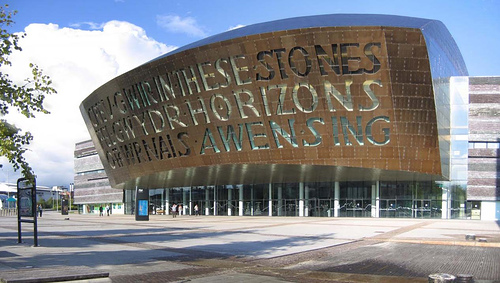
Wales Millennium Centre
Cardiff has many cultural sites varying from the historical Cardiff Castle and out of town Castell Coch to the more modern Wales Millennium Centre and Cardiff Bay. Cardiff was a finalist in the European Capital of Culture 2008.[175] In recent years Cardiff has grown in stature as a tourist destination, with recent accolades including Cardiff being voted the eighth favourite UK city by readers of the Guardian.[176] The city was also listed as one of the top 10 destinations in the UK on the official British tourist boards website Visit Britain,[177] and US travel guide Frommers have listed Cardiff as one of 13 top destinations worldwide for 2008.[178] Annual events in Cardiff that have become regular appearances in Cardiff's calendar include Sparks in the Park, The Great British Cheese Festival, Cardiff Mardi Gras, Cardiff Winter Wonderland, Cardiff Festival and Made in Roath.
Music and performing arts
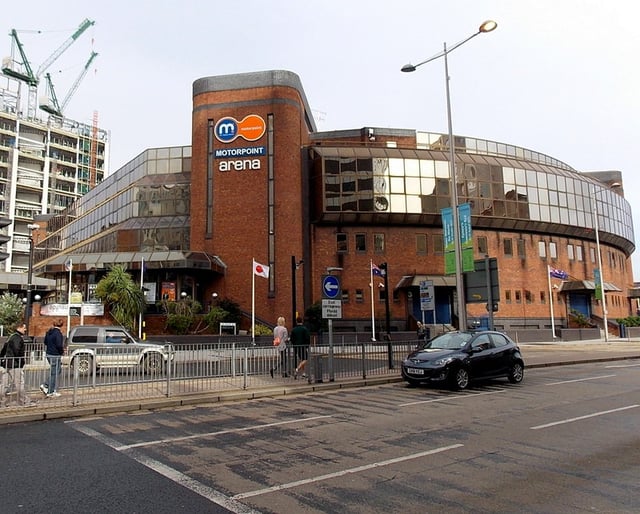
Motorpoint Arena Cardiff
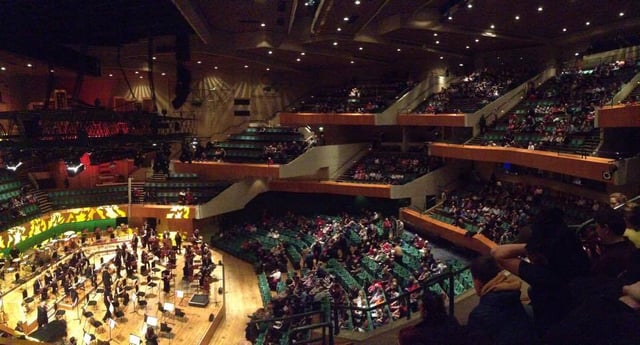
St David's Hall
A large number of concerts are held within the city, the larger ones being performed in St David's Hall, the Motorpoint Arena (previously known as the Cardiff International Arena) and occasionally the Principality Stadium. A number of festivals are also held in Cardiff—the largest of these is the Cardiff Big Weekend Festival, which is held annually in the city centre during the summer and plays host to free musical performances (from artists such as Ash, Jimmy Cliff, Cerys Matthews, the Fun Loving Criminals, Soul II Soul and the Magic Numbers), fairground rides and cultural events such as a Children's Festival that takes place in the grounds of Cardiff Castle. The annual festival claims to be the UK's largest free outdoor festival, attracting over 250,000 visitors in 2007.[179]
Cardiff hosted the National Eisteddfod in 1883, 1899, 1938, 1960, 1978, 2008 and 2018. Cardiff is unique in Wales in having two permanent stone circles used by the Gorsedd of Bards during Eisteddfodau. The original circle stands in Gorsedd Gardens in front of the National Museum while its 1978 replacement is situated in Bute Park. Since 1983, Cardiff has hosted the BBC Cardiff Singer of the World competition, a world-renowned event on the opera calendar which is held every two years. The city also hosts smaller events.
A number of performing arts venues are located within the city. The largest and most prominent of these is the Wales Millennium Centre, which hosts performances of opera, ballet, dance, comedy and musicals, and (as of autumn 2008) is home to the BBC National Orchestra of Wales. St David's Hall (which hosts the Singer of the World competition) has regular performances of classical music and ballet as well as music of other genres. The largest of Cardiff's theatres is the New Theatre, situated in the city centre just off Queen Street. Other such venues include the Sherman Theatre, Chapter Arts Centre and the Gate Arts Centre.
The Cardiff music scene is established and wide-ranging: it is home to the BBC National Orchestra of Wales and Welsh National Opera, has produced several leading acts itself and, as a capital city, has acted as a springboard for numerous Welsh bands to become famous both nationally and internationally. Acts hailing from Cardiff include Charlotte Church, Shirley Bassey, Iwan Rheon, the Oppressed, Kids In Glass Houses, Los Campesinos, the Hot Puppies, the School, We're No Heroes, Budgie and Shakin' Stevens. Also, performers such as the Automatic,[180] Manic Street Preachers,[181] Lostprophets,[182] Super Furry Animals, Catatonia and Bullet for My Valentine have links with the city and are associated with the Cardiff music scene.[183] In 2010, Cardiff was named the UK's second 'most musical' city by PRS for Music.[184]
Visual arts
Cardiff has held a photomarathon in the city each year since 2004, in which photographers compete to take the best 12 pictures of 12 previously unknown topics in 12 hours. An exhibition of the winners and other entries is held in June / July each year.[185]
Recreation

Bute Park
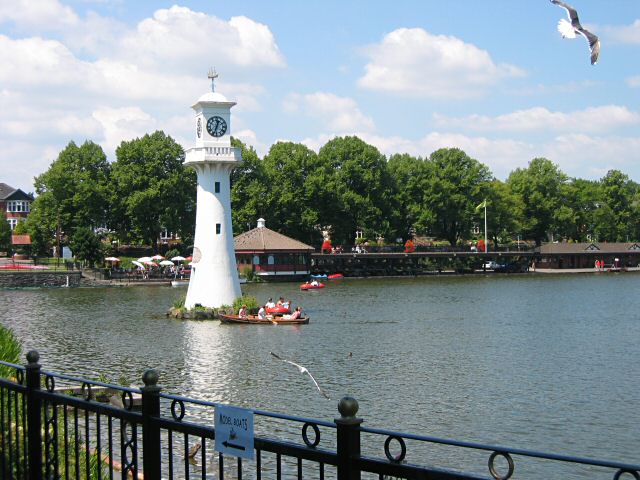
The lake at Roath Park, including the lighthouse erected as a memorial to Captain Scott
Cardiff has a strong nightlife and is home to many bars, pubs and clubs. Most clubs and bars are situated in the city centre, especially St. Mary Street, and more recently Cardiff Bay has built up a strong night scene, with many modern bars & restaurants. The Brewery Quarter on St. Mary Street is a recently developed venue for bars and restaurant with a central courtyard. Charles Street is also a popular part of the city.
Cardiff is known for its extensive parkland, with parks and other such green spaces covering around 10% of the city's total area.[186] Cardiff's main park, Bute Park (which was formerly the castle grounds) extends northwards from the top of one of Cardiff's main shopping street (Queen Street); when combined with the adjacent Llandaff Fields and Pontcanna Fields to the north west it produces a massive open space skirting the River Taff. Other popular parks include Roath Park in the north, donated to the city by the 3rd Marquess of Bute in 1887 and which includes a very popular boating lake; Victoria Park, Cardiff's first official park; and Thompson's Park, formerly home to an aviary removed in the 1970s. Wild open spaces include Howardian Local Nature Reserve, 32 acres (130,000 m2) of the lower Rhymney valley in Penylan noted for its Orchids,[187] and Forest Farm Country Park, over 150 acres (0.61 km2) along the river Taff in Whitchurch.
Cardiff is one of the top ten retail destinations in the UK,[153][188] with two main shopping streets (Queen Street and St. Mary Street), and three main shopping arcades; St. David's Centre, Queens Arcade and the Capitol Centre. The current expansion of St. David's Centre as part of the St. David's 2 project has seen it become one of the largest shopping centres in the United Kingdom. As well as the modern shopping arcades, the city is also home to many Victorian shopping centres, such as High Street Arcade, Castle Arcade, Wyndham Arcade, Royal Arcade and Morgan Arcade. Also of note is The Hayes, home to Spillers Records, the world's oldest record shop.[189][190] Cardiff has a number of markets, including the vast Victorian indoor Cardiff Central Market and the newly established Riverside Community Market, which specialises in locally produced organic produce. Several out-of-town retail parks exist, such as Newport Road, Culverhouse Cross, Cardiff Gate and Cardiff Bay.
Media

The South Wales Echo and Western Mail
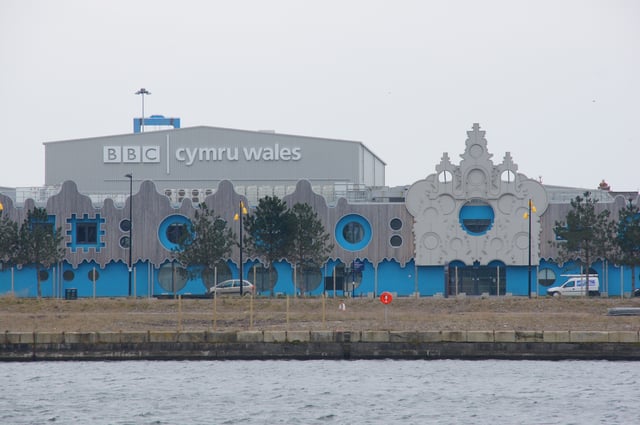
BBC's Roath Lock studios
Cardiff is the Welsh base for the main national broadcasters (BBC Cymru Wales, ITV Wales and S4C). A locally based television station, Made in Cardiff, is also based in the city centre. Major filming studios in Cardiff include the BBC's Roath Lock Studios and Pinewood Studios Wales.
Several contemporary television programmes and films are filmed in and/or set in Cardiff such as Casualty, Doctor Who, Merlin, The Sarah Jane Adventures, Torchwood, The Valleys, Upstairs Downstairs and Sherlock.[191]
The main local newspaper is the South Wales Echo and the national paper is the Western Mail. Both are based in Park Street in the city centre.
Capital Times, Echo Extra and the South Wales edition of Metro are also based and distributed in the city. There are also a number of magazines based in the city including Buzz magazine, Primary Times and a monthly papur bro, or Welsh-language community newsletter, called Y Dinesydd (The Citizen). A number of radio stations serve the city and are based in Cardiff, including Capital FM (South Wales), Heart (South and West Wales), BBC Radio Wales, BBC Radio Cymru, Nation Radio, Radio Cardiff, Smooth Radio (Wales) and Xpress Radio.
The Principality Stadium was one of the first six British landmarks to be fully mapped on Google Street View as a 360-degree virtual tour.[192]
Sport
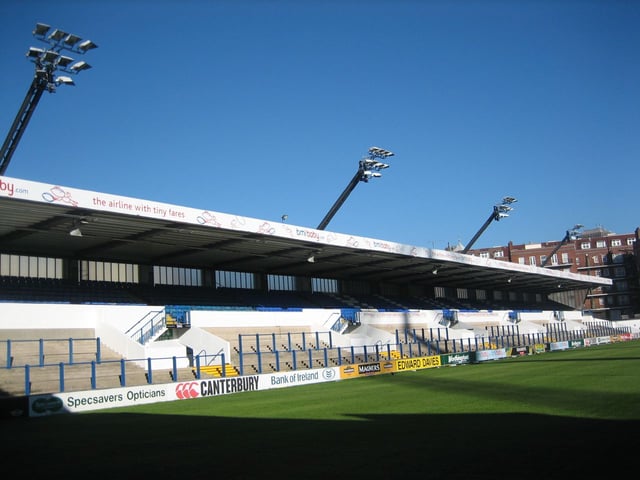
Cardiff Arms Park

Principality Stadium
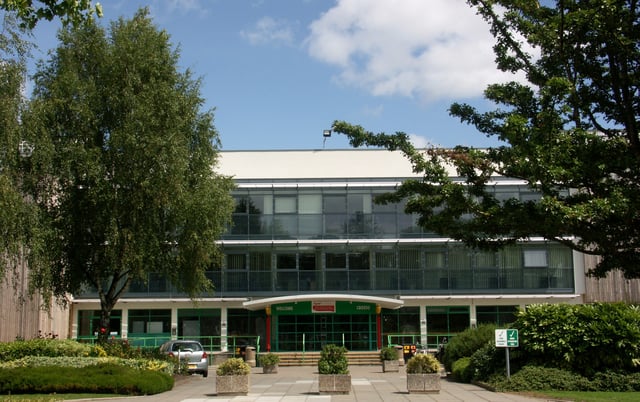
Sport Wales National Centre, Cardiff, headquarters of Sport Wales, the Welsh Sports Association and the Federation of Disability Sport Wales
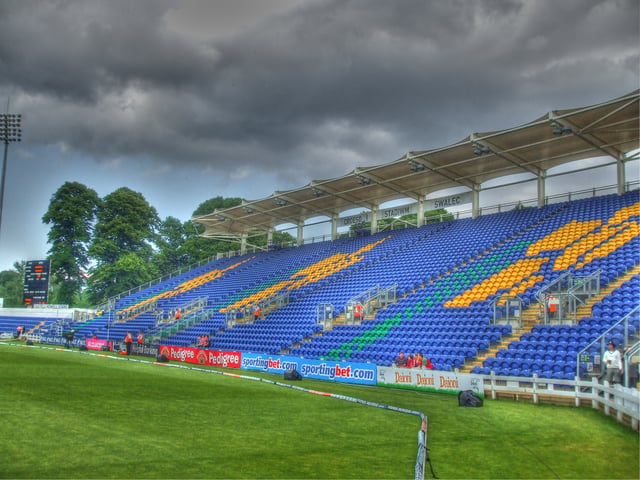
SWALEC Stadium
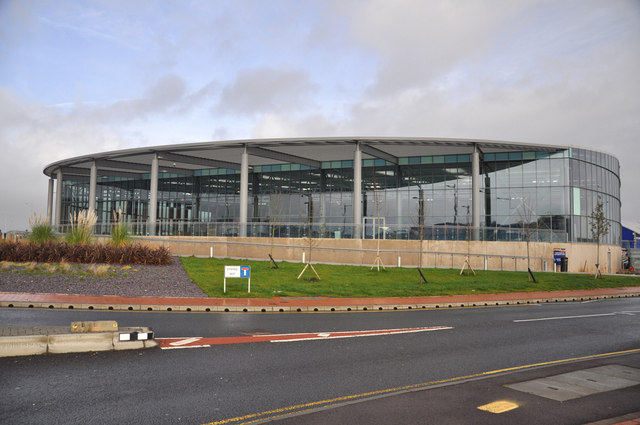
Cardiff International Pool at the International Sports Village, Cardiff Bay
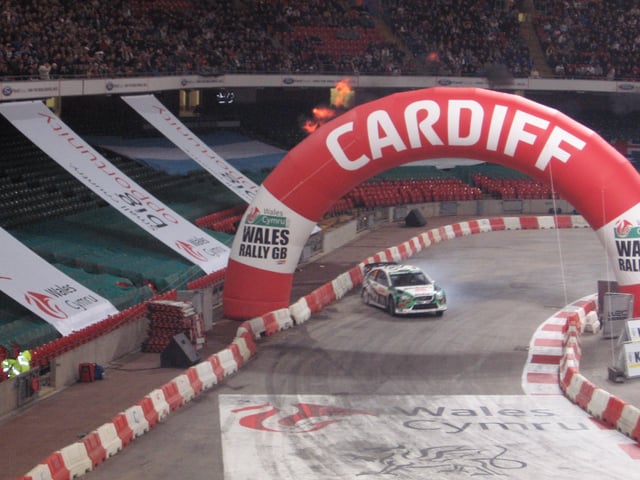
A stage of Wales Rally GB, hosted inside the Principality Stadium
Cardiff plays host to many high-profile sporting events at local, national and international level and in recognition of the city's commitment to sport for all Cardiff has been awarded the title of European Capital of Sport 2014.[193][194][195] Organised sports have been held in the city since the early 19th century.[196] national home sporting fixtures are nearly always played in the city. All Wales' multi-sports agencies and many of the country's sports governing bodies have their headquarters in Cardiff and the city's many top quality venues have attracted world-famous sports events, sometimes unrelated to Cardiff or to Wales. In 2008/09, 61% of Cardiff residents regularly participated in sport and active recreation, the highest percentage out of all 22 local authorities in Wales.[197]
Rugby union fans around the world have long been familiar with the old National Stadium, Cardiff Arms Park, and its successor the Principality Stadium, which hosted the FA Cup for six years (from 2001 to 2006) it took to rebuild Wembley Stadium. In 2009, Cardiff hosted the first Ashes cricket test, between England and Australia, to be held in Wales. Cardiff hosted eight football matches of the London 2012 Olympics.[198]
Cardiff City F.C. (founded 1899 as Riverside AFC) played their home games at Ninian Park from 1910 until the end of the 2008–09 season. The club's new home is the Cardiff City Stadium, which until 2012, they rented to the Cardiff Blues the cities professional rugby union team, the Blues returning to the Arms Park. Cardiff City have played in the English Football League since the 1920–21 season, climbing to Division 1 after one season.[199][200] Cardiff City are the only non-English team to have won the FA Cup, beating Arsenal in the 1927 final at Wembley Stadium.[200] They were runners up to Portsmouth in the 2008 final, losing 1–0 at the new Wembley Stadium.[201] In the 2013/14 and 2018/19 seasons Cardiff City played in the English Premier League.
Cardiff Metropolitan University F.C. of the Athletic Union of Cardiff Metropolitan University, based in Cyncoed, play in the Cymru Premier, having been promoted from Welsh League Division One in 2016. They were winners of the Welsh League Cup for the 2018-19 season. [202] Cardiff has numerous smaller clubs including Bridgend Street A.F.C., Caerau (Ely) A.F.C., Cardiff Corinthians F.C., Cardiff Grange Harlequins A.F.C., and Ely Rangers A.F.C. who all play in the Welsh football league system.[203]
In addition to men's football teams Cardiff City Ladies of the FA Women's Premier League Southern Division are based in the city. Teams in the Welsh Premier Women's Football League are Cardiff Met. Ladies, Cyncoed Ladies and Cardiff City.
During the 1990s, London-based football club Wimbledon FC expressed interest in relocating to Cardiff, having been without a home of their own since exiting Plough Lane stadium in 1991 and sharing with Crystal Palace FC at Selhurst Park. The relocation of the club to Cardiff did not happen; in 2003, the club moved to Milton Keynes and a year later rebranded as Milton Keynes Dons.[204]
Cardiff Arms Park (Welsh: Parc yr Arfau Caerdydd), in central Cardiff, is among the world's most famous venues—being the scene of three Welsh Grand Slams in the 1970s (1971, 1976 and 1978) and six Five Nations titles in nine years—and was the venue for Wales' games in the 1991 Rugby World Cup.[205][206][207][208] The Arms Park has a sporting history dating back to at least the 1850s, when Cardiff Cricket Club (formed 1819) relocated to the site.[196] The ground was donated to Cardiff CC in 1867 by the Marquess of Bute. Cardiff Cricket Club shared the ground with Cardiff Rugby Football Club (founded 1876) —forming Cardiff Athletic Club between them—until 1966, when the cricket section moved to Sophia Gardens. Cardiff Athletic Club and the Welsh Rugby Union established two stadia on the site—Cardiff RFC played at their stadium at the northern end of the site, and the Wales national rugby union team played international matches at the National Stadium, Cardiff Arms Park, which opened in 1970. The National Stadium was replaced by the 74,500 capacity Millennium Stadium (Welsh: Stadiwm y Mileniwm) in 1999—in time for the 1999 Rugby World Cup—and is home stadium to the Wales national rugby and football teams for international matches.[196][205][209][210] In addition to Wales' Six Nations Championship and other international games, the Principality Stadium held four matches in the 2007 Rugby World Cup and six FA Cup finals (from the 2001–02 to 2005–06 seasons) while Wembley Stadium was being rebuilt.[206]
Cardiff Cricket Club were formed in 1819, and Glamorgan County Cricket Club have competed as a first class county since 1921. Their headquarters and ground is the SWALEC Stadium, Sophia Gardens, since moving from Cardiff Arms Park in 1966. The Sophia Gardens stadium underwent a multimillion-pound improvement since being selected to host the first ‘England’ v Australia Test Match of the 2009 Ashes series.[196][211]
Cardiff has a long association with boxing, from 'Peerless' Jim Driscoll—born in Cardiff in 1880—to more recent, high-profile fights staged in the city.[212] These include the WBC Lennox Lewis vs. Frank Bruno heavyweight championship fight at the Arms Park in 1993, and many of Joe Calzaghe's fights, between 2003 and 2007.
Cardiff's professional ice hockey team, the Cardiff Devils, play in the 3000-seater Ice Arena Wales in the Cardiff International Sports Village. They play in the 12 team professional Elite Ice Hockey League. Founded in 1986, and one of the most successful British teams during the nineties.
Cardiff's only American flag football team are the Hurricanes. They won the British Championship in 2014 after falling short by 2 points in a quarter final to eventual winners, the London Rebels the previous year. They are based out of Roath Recreational Ground.
The 1958 Commonwealth Games were hosted by Cardiff. The Games involved 1,130 athletes from 35 national teams competing in 94 events.[213] One of the venues for those Games—The Wales Empire Swimming Pool—was demolished in 1998 to make way for the Principality Stadium. The GBP32m Cardiff International Pool in Cardiff Bay, opened to the public on 12 January 2008—part of the GBP1bn International Sports Village (ISV)—is the only Olympic-standard swimming pool in Wales. When complete, the ISV complex will provide Olympic standard facilities for sports including boxing and fencing, gymnastics, judo, white water events (including canoeing and kayaking) and wrestling as well as a snow dome with real snow for skiing and snowboarding, an arena for public ice skating and ice hockey and an hotel.[214][215] Some of the sports facilities at the ISV were to be used as training venues for the London 2012 Olympics.[216]
The Principality Stadium hosts motorsport events such as the World Rally Championship, as part of Wales Rally GB. The first ever indoor special stages of the World Rally Championship were held at the Principality Stadium in September 2005 and have been an annual event sincve then.[217] The British Speedway Grand Prix, one of the World Championship events, is held at the Millennium Stadium.[210] While the track—a temporary, purpose built, shale oval—is not universally loved, the venue is considered the best of the World Championship's 11 rounds.[218]
The Cardiff International Sports Stadium, opened 19 January 2009, replacing the Cardiff Athletics Stadium; demolished to make way for the Cardiff City Stadium was a 4,953 capacity, multi sport/special event venue, offering fully certificated international track and field athletics facilities, including an international standard external throws area.[219][220][221] The stadium houses the Headquarters of Welsh Athletics, the sport's governing body for Wales.[222] The city's indoor track and field athletics sports venue is the National Indoor Athletics Centre, an international athletics and multi sports centre at the University of Wales Institute, Cardiff Campus, Cyncoed.[223]
During the 1990s, London based football club Wimbledon F.C. expressed interest in relocating to the city, having been without a home of their own since exiting their own Plough Lane stadium in 1991 and ground-sharing with Crystal Palace at Selhurst Park. However, the relocation of the club to Cardiff never happened, and in 2003 the club moved to Milton Keynes in Buckinghamshire, being rebranded as Milton Keynes Dons a year later.[204]
Notable people
Many notable people have hailed from Cardiff, ranging from historical figures such as the 12th-century Welsh leader Ifor Bach and to more recent figures such as Roald Dahl, Ken Follett, Griff Rhys Jones and the former Blue Peter presenter Gethin Jones.
The notable actors of Cardiff include Ioan Gruffudd (notable performances are film roles such as Lancelot in King Arthur (2004), Mister Fantastic (Reed Richards) in Fantastic 4 (2005) and its sequel Fantastic 4: Rise of the Silver Surfer (2007)), and Iwan Rheon.
Also notable is Siân Grigg, BAFTA winner and Oscar nominated Hollywood make up artist.
In particular, the city has been the birthplace of sports stars such as Tanni Grey-Thompson and Colin Jackson as well as many Premier League, Football League and international footballers, such as Craig Bellamy, Gareth Bale, Ryan Giggs, Joe Ledley, and former managers of the Wales national football team Terry Yorath and John Toshack. International rugby league players from Cardiff include Frank Whitcombe, Billy Boston, David Willicombe and Colin Dixon. International Rugby Union Jamie Roberts, Jamie Robinson, Nicky Robinson, Rhys Patchell, and baseball internationals include George Whitcombe and Ted Peterson.
Saint Teilo (c. 500 – 9 February c. 560), is the patron saint of Cardiff. He was a British Christian monk, bishop, and founder of monasteries and churches. Reputed to be a cousin, friend, and disciple of Saint David, he was bishop of Llandaff and founder of the first church at Llandaff Cathedral, where his tomb is. His Saint's Day is ninth of February.
Cardiff is also well known for its musicians, such as Ivor Novello, after whom the Ivor Novello Awards are named. Idloes Owen, founder of the Welsh National Opera, lived in Llandaff, Shirley Bassey is familiar to many as the singer of three James Bond movie theme tunes, while Charlotte Church is famous as a crossover classical/pop singer. Shakin' Stevens was one of the top selling male artists in the UK during the 1980s. Tigertailz, a popular glam metal act in the 80s, also hailed from Cardiff. A number of Cardiff-based bands, such as Catatonia and Super Furry Animals were popular during the 1990s.[224]
Twin towns and sister cities
Cardiff has twinning arrangements with:[225]
[[INLINE_IMAGE|//upload.wikimedia.org/wikipedia/commons/thumb/4/49/Flag_of_Ukraine.svg/23px-Flag_of_Ukraine.svg.png|//upload.wikimedia.org/wikipedia/commons/thumb/4/49/Flag_of_Ukraine.svg/35px-Flag_of_Ukraine.svg.png 1.5x, //upload.wikimedia.org/wikipedia/commons/thumb/4/49/Flag_of_Ukraine.svg/45px-Flag_of_Ukraine.svg.png 2x|Ukraine|h15|w23|thumbborder flagicon-img flagicon-img]] Luhansk, Ukraine[225]
[[INLINE_IMAGE|//upload.wikimedia.org/wikipedia/commons/thumb/d/d9/Flag_of_Norway.svg/21px-Flag_of_Norway.svg.png|//upload.wikimedia.org/wikipedia/commons/thumb/d/d9/Flag_of_Norway.svg/32px-Flag_of_Norway.svg.png 1.5x, //upload.wikimedia.org/wikipedia/commons/thumb/d/d9/Flag_of_Norway.svg/41px-Flag_of_Norway.svg.png 2x|Norway|h15|w21|thumbborder flagicon-img flagicon-img]] Hordaland county, Norway[225]
[[INLINE_IMAGE|//upload.wikimedia.org/wikipedia/commons/thumb/4/48/Flag_of_Bolivia.svg/22px-Flag_of_Bolivia.svg.png|//upload.wikimedia.org/wikipedia/commons/thumb/4/48/Flag_of_Bolivia.svg/34px-Flag_of_Bolivia.svg.png 1.5x, //upload.wikimedia.org/wikipedia/commons/thumb/4/48/Flag_of_Bolivia.svg/44px-Flag_of_Bolivia.svg.png 2x|Bolivia|h15|w22|thumbborder flagicon-img flagicon-img]] Sucre, Bolivia[225]
[[INLINE_IMAGE|//upload.wikimedia.org/wikipedia/en/thumb/c/c3/Flag_of_France.svg/23px-Flag_of_France.svg.png|//upload.wikimedia.org/wikipedia/en/thumb/c/c3/Flag_of_France.svg/35px-Flag_of_France.svg.png 1.5x, //upload.wikimedia.org/wikipedia/en/thumb/c/c3/Flag_of_France.svg/45px-Flag_of_France.svg.png 2x|France|h15|w23|thumbborder flagicon-img flagicon-img]] Nantes, France[225][226]
[[INLINE_IMAGE|//upload.wikimedia.org/wikipedia/en/thumb/b/ba/Flag_of_Germany.svg/23px-Flag_of_Germany.svg.png|//upload.wikimedia.org/wikipedia/en/thumb/b/ba/Flag_of_Germany.svg/35px-Flag_of_Germany.svg.png 1.5x, //upload.wikimedia.org/wikipedia/en/thumb/b/ba/Flag_of_Germany.svg/46px-Flag_of_Germany.svg.png 2x|Germany|h14|w23|thumbborder flagicon-img flagicon-img]] Stuttgart, Germany[225]
[[INLINE_IMAGE|//upload.wikimedia.org/wikipedia/commons/thumb/f/fa/Flag_of_the_People%27s_Republic_of_China.svg/23px-Flag_of_the_People%27s_Republic_of_China.svg.png|//upload.wikimedia.org/wikipedia/commons/thumb/f/fa/Flag_of_the_People%27s_Republic_of_China.svg/35px-Flag_of_the_People%27s_Republic_of_China.svg.png 1.5x, //upload.wikimedia.org/wikipedia/commons/thumb/f/fa/Flag_of_the_People%27s_Republic_of_China.svg/45px-Flag_of_the_People%27s_Republic_of_China.svg.png 2x|China|h15|w23|thumbborder flagicon-img flagicon-img]] Xiamen, China[225]
[[INLINE_IMAGE|//upload.wikimedia.org/wikipedia/commons/thumb/c/cf/Flag_of_Peru.svg/23px-Flag_of_Peru.svg.png|//upload.wikimedia.org/wikipedia/commons/thumb/c/cf/Flag_of_Peru.svg/35px-Flag_of_Peru.svg.png 1.5x, //upload.wikimedia.org/wikipedia/commons/thumb/c/cf/Flag_of_Peru.svg/45px-Flag_of_Peru.svg.png 2x|Peru|h15|w23|thumbborder flagicon-img flagicon-img]] Lima, Peru[225]
A total of 28 countries have a diplomatic presence in Cardiff.[227] Many of these nations, such as Germany, Italy, Switzerland, Denmark, Canada, Thailand and the Czech Republic are represented by honorary consulates. The British Embassy of the United States operates a satellite office.[228][229][230][231][232][233][234][235]
See also
Cardiff city centre
Cardiff music scene
List of cultural venues in Cardiff
List of Parliamentary constituencies in South Glamorgan
List of places in Cardiff
List of places of worship in Cardiff
List of streets and squares in Cardiff
National Assembly for Wales
Big Number Change
Telephone numbers in the United Kingdom
OPENCities
UK telephone code misconceptions




